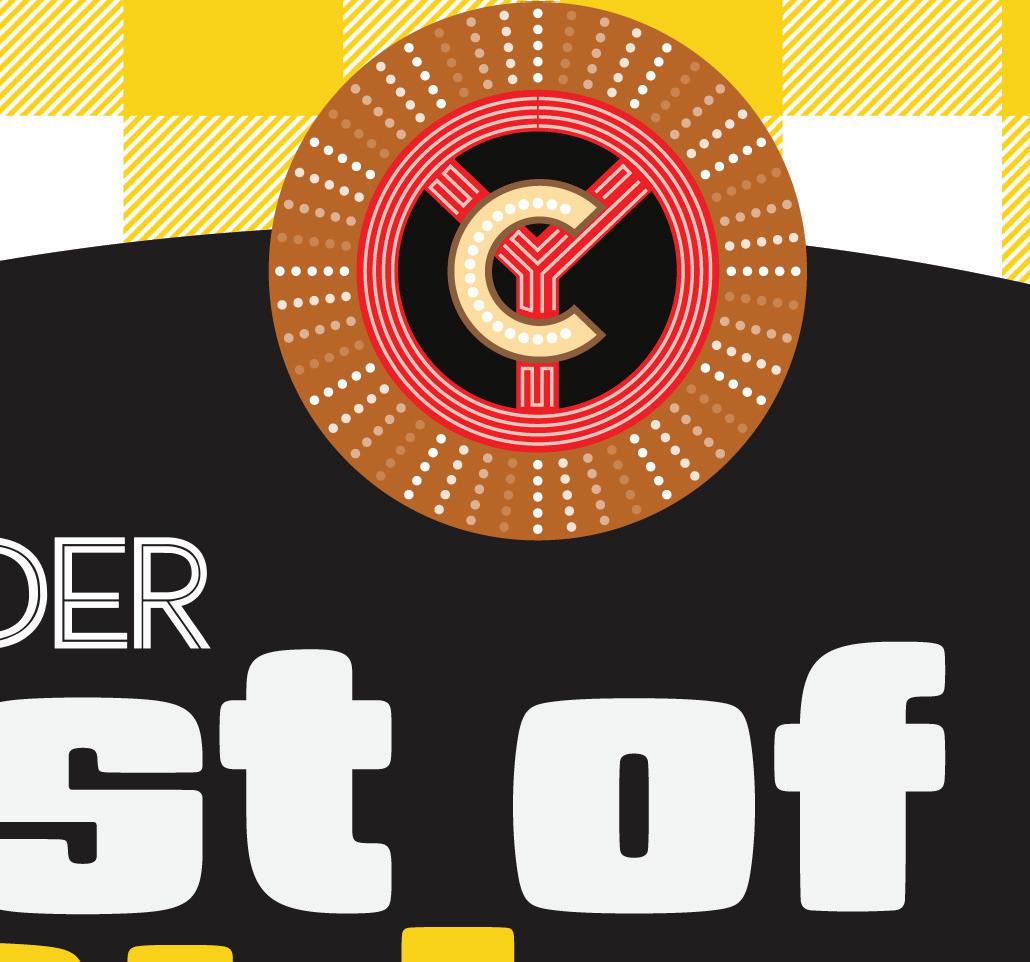

THIS WEEK
CITY LIFE
03 Editor’s Note | Cardoza Covering books all year-round
04 Feature A er 58 years, Third World Press continues to build upon its radical roots.
FOOD & DRINK
06 Feature | Sula New and upcoming local food books you should read
NEWS & POLITICS
08 Labor Pains | Brown Howard Brown Health nurses inch closer to a strike.
09 Make It Make Sense | Mulcahy Community members decry immigration raids, the CPD’s second in command is stepping down, and Northwestern students boycott “antibias” training.
ARTS & CULTURE
10 Review | Reid Maggie Andersen’s memoir is an inside look at Chicago’s storefront theater scene.
11 Review | Friedman-Parks Andrea Carlson’s debut monograph disrupts colonial narratives.
12 Preview | Hugueley A new fair for comics and small presses comes to the Chicago Athletic Hotel.
THEATER
13 Review | Reid Theodore Ward’s landmark Big White Fog gets a stellar revival at Court Theatre.
14 Show of Note Gangsta Baby at Open Space Arts
15 Feature Chase Infiniti is Chicago’s latest claim to fame.
17 Moviegoer Talk to the hand.
MUSIC & NIGHTLIFE
18 Feature | Galil DIY dynamo Pancho García helps sustain the southwest-side Latine hardcore scene.
20 Feature | Montoro It’s time to show up for the World Music Festival.
23 Gossip Wolf Chicago indie musicians organize to spurn Spotify via open letter, the Hyde Park Jazz Festival returns for year 19, and more.
24 Shows of Note Previews of concerts including the Blessed Madonna, Closed Casket, Maruja, and Makaya McCraven
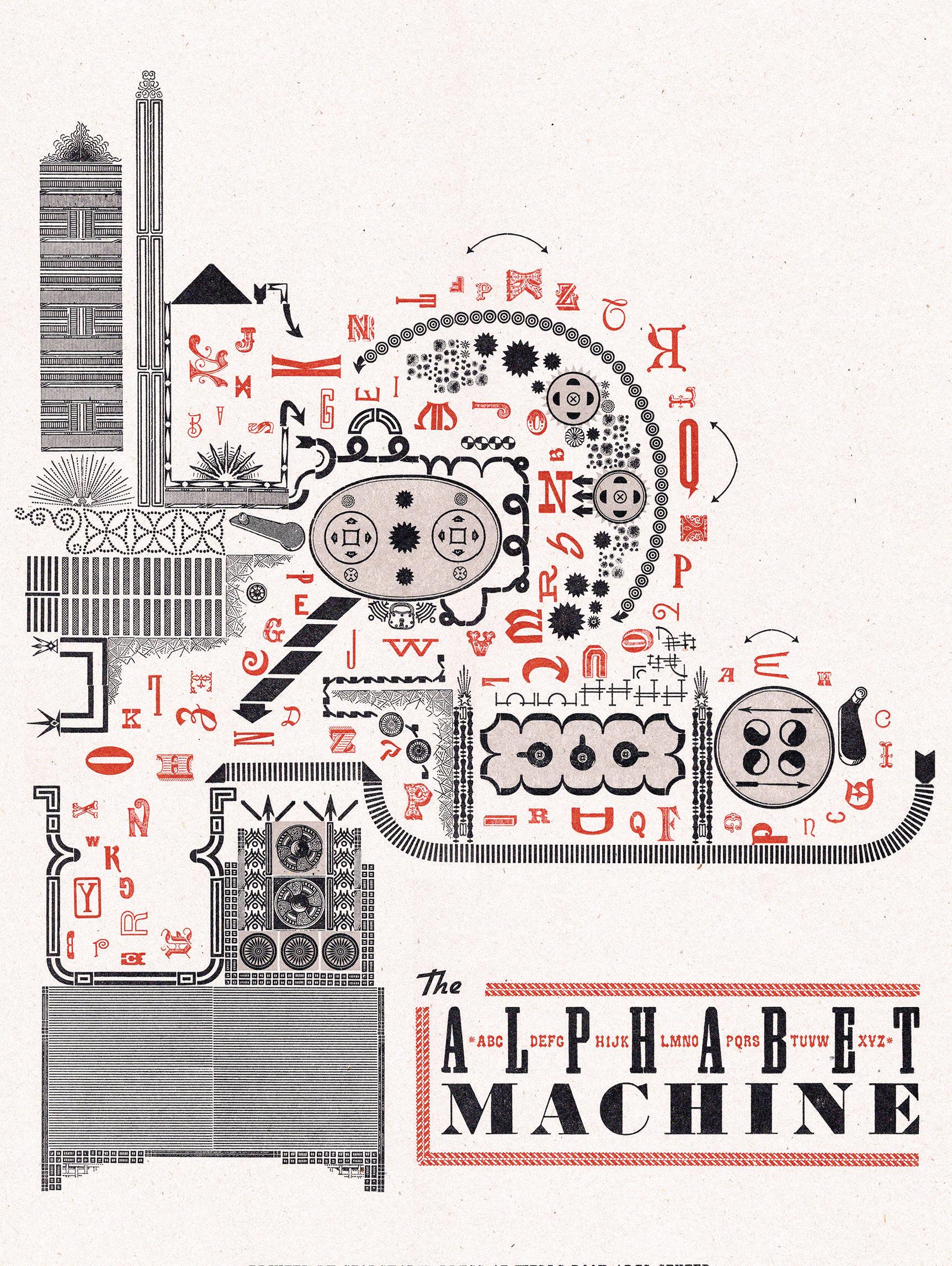
INTERIM PUBLISHER ROB CROCKER
DIRECTOR OF ADVERTISING AND REVENUE
PRODUCTS AMBER NETTLES CHIEF OF STAFF ELLEN KAULIG
ASSISTANT MANAGING EDITOR
SAVANNAH RAY HUGUELEY
PRODUCTION MANAGER AND STAFF
PHOTOGRAPHER KIRK WILLIAMSON
SENIOR GRAPHIC DESIGNER AMBER HUFF
GRAPHIC DESIGNER AND PHOTO RESEARCHER SHIRA
FRIEDMAN-PARKS
THEATER AND DANCE EDITOR KERRY REID
MUSIC EDITOR PHILIP MONTORO
CULTURE EDITOR: FILM, MEDIA, FOOD AND DRINK TARYN MCFADDEN
Book Season , a letterpress print by Jen Farrell of Starshaped Press, altered with permission. For more by Starshaped Press, visit starshaped.com or @starshapedpress on Instagram. Cover design by Shira Friedman-Parks.
CULTURE EDITOR: ART, ARCHITECTURE, BOOKS KERRY CARDOZA
NEWS EDITOR SHAWN MULCAHY
PROJECTS EDITOR JAMIE LUDWIG
DIGITAL EDITOR TYRA NICOLE TRICHE
SENIOR WRITERS LEOR GALIL, MIKE SULA
FEATURES WRITER KATIE PROUT
SOCIAL JUSTICE REPORTER DEVYN-MARSHALL BROWN (DMB)
STAFF WRITER MICCO CAPORALE
SOCIAL MEDIA ENGAGEMENT
ASSOCIATE CHARLI RENKEN
VICE PRESIDENT OF PEOPLE AND CULTURE ALIA GRAHAM
DEVELOPMENT MANAGER JOEY MANDEVILLE
DATA ASSOCIATE TATIANA PEREZ
MARKETING ASSOCIATE MAJA STACHNIK
MARKETING ASSOCIATE MICHAEL THOMPSON
SALES REPRESENTATIVE WILL ROGERS
SALES REPRESENTATIVE KELLY BRAUN
SALES REPRESENTATIVE VANESSA FLEMING
ADVERTISING
ADS@CHICAGOREADER.COM, 312-392-2970
CREATE A CLASSIFIED AD LISTING AT CLASSIFIEDS.CHICAGOREADER.COM
DISTRIBUTION CONCERNS
DISTRIBUTIONISSUES@CHICAGOREADER.COM
READER INSTITUTE FOR COMMUNITY JOURNALISM, INC.
CHAIRPERSON EILEEN RHODES
TREASURER TIMO MARTINEZ
SECRETARY TORRENCE GARDNER
DIRECTORS MONIQUE BRINKMAN-HILL, JULIETTE BUFORD, DANIEL DEVER, MATT DOUBLEDAY, JAKE MIKVA, ROBERT REITER, MARILYNN RUBIO, CHRISTINA CRAWFORD STEED
READER (ISSN 1096-6919) IS PUBLISHED WEEKLY BY THE READER INSTITUTE FOR COMMUNITY JOURNALISM 2930 S. MICHIGAN, SUITE 102 CHICAGO, IL 60616, 312-3922934, CHICAGOREADER.COM
COPYRIGHT © 2025 CHICAGO READER ALL RIGHTS RESERVED. CHICAGO READER, READER, AND REVERSED R: REGISTERED TRADEMARKS ® TO CONTACT ANY READER EMPLOYEE, EMAIL: (FIRST INITIAL)(LAST NAME) @CHICAGOREADER.COM
EDITOR’S NOTE

“The lineup of exceptional authors, presenters, and booksellers produced the biggest and best Printers Row Lit Fest in its 40-year history,” said spokesperson Brian Berg. DON SEELEY
At the Reader , we cover books all year—from our Best of Chicago issue, which spotlights bookstores working to build community or magazine shops that feature live music and obscure titles, to our yearly gift guide (local titles, storytelling classes) and our end-of-year roundups, to regular reviews and features. But fall is a special time of year for book publishing, as evidenced by this year’s 40th edition of the Printers Row Lit Fest; tons of new titles come out just in time for the weather to start to turn, making it all the more enticing to stay in with a book. Regrettably, we can’t cover even a fraction of the incredible things happening locally in books and lit, let alone nationally. But for this issue, our third annual fall books preview, we o er a handful of recommendations geared toward a range of interests, including artist Andrea Carlson’s debut monograph and an inside look at our city’s storied storefront theater scene. We’ve also got a brief history of Chicago’s Third World Press (the world’s oldest African-centered book publisher), a roundup of new and upcoming food and drink publications, and a preview of Pretty Good Fest, a new comics and small press fair taking place on October 4 at the Chicago Athletic Hotel. Hopefully, there’s a title in this issue that catches your eye. And, if you like what you read here, make sure to sign up for our bimonthly arts and culture newsletter, Second & Fourth, where we often offer other books

ATTENTION
ATTENTION: PUBLIC COMMENT PERIOD FOR CHA’S PROPOSED SENIOR DESIGNATED HOUSING PLAN (SDHP) SEPTEMBER 18 – OCTOBER 17, 2025
If you listed Lawndale Complex or the Lawndale Community Area on your Housing Choice Survey as a place you would like to permanently live, please read the information listed below.
and lit recommendations on the fly. As always, thanks for reading. v
—Kerry Cardoza, culture editor m kcardoza@chicagoreader.com
Reader Letters m
CORRECTION
The Reader has updated the online version of the Riefenstahl film review, written by Dmitry Samarov and originally published in our September 19 issue (volume 54, number 50). The original version of this story was incorrectly attributed to writer Noah Berlatsky. v
Find us on socials: facebook.com/chicagoreader twitter.com/Chicago_Reader instagram.com/chicago_reader linkedin.com search chicago-reader
The Chicago Reader accepts comments and letters to the editor of less than 400 words for publication consideration. m letters@chicagoreader.com
The Chicago Housing Authority (CHA) is releasing its proposed Senior Designated Housing Plan (SDHP) for public comment from September 18 through October 17, 2025. The changes made to these policies are to ensure compliance with federal regulations and state and local laws, as well as to allow CHA to adopt or change housing management practices. The proposed SDHP and SDHP Summary documents are available for review on CHA’s website at www.thecha.org starting September 18th.
The Draft Tenant Selection Plan (TSP) and Lease for Ogden Commons, a mixed-income community is available for review. The Chicago Housing Authority (CHA) has worked with its development partner to develop a Draft TSP and Lease for use at the private development known as Ogden Commons (previous site of the Lawndale Complex). The units within this development will be used as replacement public housing units for Lawndale Complex and the Lawndale Community area. If you listed Lawndale Complex/Lawndale Community area on your Housing Choice Survey as a place you want to live or maintain a right to return to new CHA replacement housing per the Relocation Rights Contract (RRC), you can comment on the Draft TSP and Lease during the 30-day public comment period.
While CHA encourages and welcomes all program participants, residents, and the community-at-large to review the proposed updates to the SDHP and attend the hearings, you are not required to attend the public comment hearings or submit comments. A sign-interpreter and translators will be available at each location during the comment hearings. The date, time, and location of the public comment hearings are as follows:
The 30-day public comment period will be held for CHA to receive written comments starting April 7 through May 7, 2021. The Tenant Selection Plans (TSP) will be available on CHA’s website beginning April 7, 2021.
• Thu, Sept 25, 2:00, Lincoln Perry Annex, 3245 S Prairie
• Tue, Sept 30, 2:00, Edith Spurlock, 2700 N Sheffield
• Wed, Oct 8, 2:00, Albany Terrace, 3030 W 21st Pl
Due to COVID-19, CHA has suspended all in person public meetings and instead, CHA will livestream one public comment hearing. The date and time of the public comment livestream hearing is as follows:
Tue, April 20, 10:00am: https://youtu.be/QBGG47BHXMg
Additionally, CHA will produce a video that outlines the updates to the FY2025 SDHP to view at your convenience. The video will be available for viewing after September 22 and will be available at www.thecha.org.
Public housing residents, RAD Program participants, and the public may submit comments on the Proposed SDHP during the public comment period.
We ask that comments pertaining to the TSP & Lease be submitted electronically to commentontheplan@thecha.org at least 48-hours prior to the comment hearing. Comments will be read live during the time outlined above. Comments received after the hearing will be added to the comment grid.
You can submit comments on the proposed plan by email, fax or mail:
E-mail or Fax comments to: commentontheplan@thecha.org Fax 312. 913.7837
Chicago Housing Authority 60 E. Van Buren St, 12th Floor Chicago, IL 60605 Attn: Proposed FY2025 SDHP Email: commentontheplan@thecha.org | Fax: 312-913-7837
If you require translation services, please read the attached notice or check with your property manager for more details. Do not mail comments to CHA.
Ifyouhaveaquestionaboutthisnotice,pleasecalltheCHAat312.913-7300. Torequestareasonableaccommodation,pleasecall312.913.7062. TTY 866.331.3603
If you have a question about this notice, please call 312-913-7300. To request a reasonable accommodation, please call 312-913-7062. TTY 866-331-3603

BOOKS
Building a living, Black literary archive
Third World Press Foundation and the Vivian G. Harsh Research Collection build upon the legacy of Chicago’s south side as a hub of “Black creativity, intellect, and political imagination.”
By JASMINE BARNES
One of Haki R. Madhubuti’s first encounters with Black literature was reading Richard Wright’s Black Boy in the segregated section of his public library in Detroit.
“For the first time in my life, I was reading literature. I was reading language that was not an insult to my own personhood,” said Madhubuti, now a best-selling author and cofounder of the oldest independent Blackowned publisher in the U.S., Third World Press. “At 14, I read Black Boy in less than 24 hours. That’s how hungry I was for anything that would give me some nurturing.”
A little over a decade later, Madhubuti would attend a workshop Gwendolyn Brooks was leading at a local church and present her with a collection of his own poetry. He recalls that she “put [the book] to her heart” and the following day they met for tea, which quickly “turned into a familyhood.” As the “cultural son” of both Brooks and beloved Chicago artist and arts organizer Margaret Burroughs, Madhubuti learned the importance of building Black institutions and devoted his life to advancing Black creativity.
For Madhubuti, literature in particular was medicine to cure the self-hatred he felt as a result of the racism and poverty that shrouded his upbringing. His introduction to the power of Black storytelling and literature would eventually lead him to start Third World Press with the late poets and writers Dr. Johari Amini-Hudson and Carolyn Rodgers in 1967.
The press’s cofounders took note of the Detroit-based Black-owned Broadside Press, which was founded a few years earlier, and sought to develop a space in Chicago that could similarly nurture Black political thought. The press has since published hundreds of books of fiction, nonfiction, poetry, and cross-genre
work that challenge dominant narratives and uplift marginalized voices. Renowned authors chose the press to publish their work, including Brooks, Amiri Baraka, and Sonia Sanchez.
What started with $400 and a used mimeograph machine in an Englewood apartment would become the spacious, half-block facility at the south end of Grand Crossing Park, where it stands today as the Third World Press Foundation (TWPF).
As one of the last remaining institutions from the Black Arts Movement, its existence is not only emblematic of resilience in the face of attacks on Black cultural institutions, but also serves as a space “where literature and learning dismantle barriers.” Celebrating their 58th anniversary this month, the foundation seeks to evolve to meet the needs of the current moment and inspire a new generation to build upon the radical roots of its founding.
RFor information on Third World Press Foundation’s upcoming programs and initiatives, follow @thirdworldpressfoundation on Instagram or Facebook. To volunteer, email Dr. Muhammad at twpfprojects@thirdworldpressfoundation.org.
building relationships across Chicago’s Black art collections.
“Praise and Protest” explores how the Chicago Black Renaissance was an incubator for local artists, scholars, and activists who reshaped U.S. culture and laid the foundation for an empowered Black cultural identity.
The archive’s namesake, Vivian G. Harsh, was Chicago’s first Black librarian and used the George Cleveland Hall Branch in Bronzeville as a space to bring together Black literary voices from across the country. In 1933, her semimonthly Book Review and Lecture Forum
published by Broadside Press in 1969), were proudly on display.
At its peak in the 1970s and ’80s, Third World Press had dozens of employees. As the publishing landscape changed, the press’s influence and resources were impacted. Currently, TWPF’s small team is largely made up of volunteers.
In 2015, the organization, which was previously a for-profit business, adopted a nonprofit status and structure. In 2023, the press announced that it would be developing a transition plan and team to assume the day-to-day running of TWPF, including creating a new leadership structure, recruiting an executive leadership team, and developing an engaged board of directors.
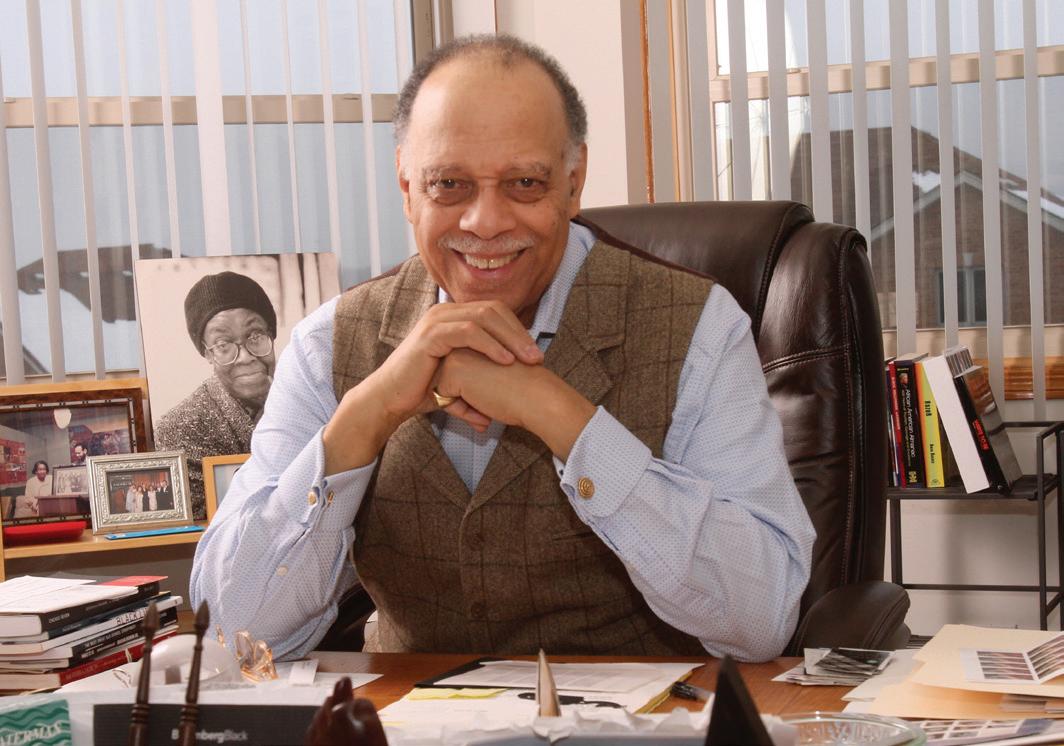
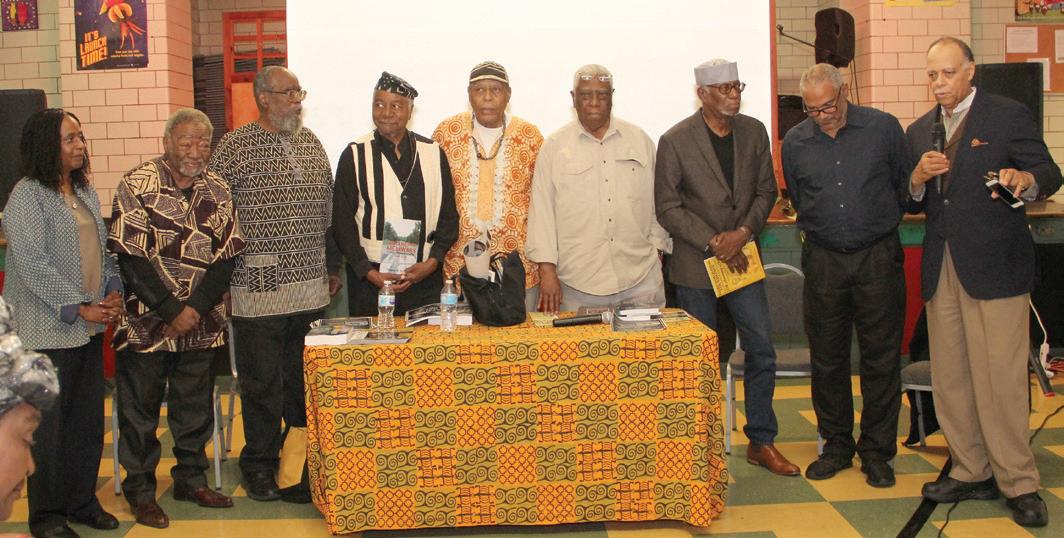
A few miles south of the TWPF o ces, the Woodson Regional Library houses the Vivian G. Harsh Research Collection—a significant archive of African American history and literature. A new exhibition at the library, “Praise and Protest: Voices From the Chicago Black Renaissance,” spotlights the Harsh collection as a treasure trove of historic images, objects, and texts from the Chicago Black Renaissance (1930-50) and the Black Arts Movement (1965-75). The exhibition grew out of the Chicago Public Library’s new Magnitude and Bond initiative, which focuses on
attracted literary giants like Langston Hughes and Zora Neale Hurston.
Chicago’s south side in particular was what the exhibition calls a hub of “Black creativity, intellect, and political imagination.” The collection shows how the Black Arts Movement was shaped by artists and institution-builders who furthered the work of their predecessors. It also highlights Third World Press as a critical space for building Black literary power; two of Madhubuti’s own bestsellers, YellowBlack (2006) and Don’t Cry, Scream (originally
Dr. Mursalata Muhammad, a professor of English at Grand Rapids Community College, has helped spearhead some structural changes that will set the press up for longevity. As a passionate champion for Black literature, she volunteers her time as the special projects manager for TWPF. Over the next two years, Muhammad sees TWPF’s main goals as developing a core staff and building the income it needs to flourish as a nonprofit. She hopes the organization can increase its financial sustainability and community engagement by activating new initiatives.
Muhammad shared plans to launch a capital campaign, develop a donor membership model, increase guided tours of TWPF’s offices, and start a membership program where individuals pay a regular fee to engage in book discussions and author talks. Other longstanding programs like the Prison Literacy Program and their book gifting program already donate books to schools, libraries, youth organizations, and incarcerated individuals as an extension of the organization’s mission. Muhammad hopes to see these programs strengthened, expanding their reach.
“The generation we have to get don’t already know the gold in the history of Third World Press,” Muhammad said. “We have to build the momentum that it had in its heyday, with stars and politicians and everyone knowing about it.”
Top: Professor Haki R. Madhubuti
Bottom, from L to R: Brenda Greene, Askia Muhammad Touré, Kalamu ya Salaam, Eugene B. Redmond, Useni Eugene Perkins, Woodie King Jr., Herb Boyd, Michael Simanga, and Haki R. Madhubuti THIRD WORLD PRESS FOUNDATION
The Vivian G. Harsh Research Collection is viewable by appointment only. Visit chipublib. org/vivian-g-harsh-research-collection for hours and details.
Celebrating their 58th anniversary this month, [Third World Press Foundation] seeks to evolve to meet the needs of the current moment and inspire a new generation to build upon the radical roots of its founding.
While TWPF’s present efforts are less familiar to younger generations, there are many exceptions. Desmond Owusu, an alumnus of Betty Shabazz International, a charter school cofounded by Madhubuti, supports TWPF with its social media.

Muhammad hopes to activate more young people by publishing the work of undiscovered authors and stewarding a new wave of writers. She also believes it’s possible to leverage the skills and curiosities of youth by working with local universities to develop internships for


home not just to books, but art and archival materials from famed artists like Annie Lee and iconic Black institutions like the Johnson Publishing Company. She sees the technological savvy and curiosity of younger generations as a way to both preserve the past and make it
BOOKS
others during the Black Arts Movement.
At the opening celebration for the “Praise and Protest” exhibition, people of all ages listened intently as Madhubuti shared reflections on his life with Englewood native and multifaceted artist Tonika Lewis Johnson. She expressed her nervousness interviewing “a legend, an icon, and someone whose shoulders [she] stand[s] on.” He quickly reassured her, calling her his daughter, his family.
“You could see that it was intergenerational,” said Owusu, in reference to the event’s audience. “Seeing the vastness in the crowd, I think, speaks to the legacy and how long the press will continue to thrive.” When reflecting on what’s inspired his devotion and commitment to the press, Madhubuti addressed the crowd directly: “If there’s one





The Vivian G. Harsh Research Collection’s “Praise and Protest” exhibition COURTESY CHICAGO PUBLIC LIBRARY
BOOKS
FOOD & DRINK
New and upcoming local food books you should read
Eat these words.
By MIKE SULA


This season’s class of local cookbooks— and one memoir—is particularly robust, and not just because most of them are sophomore e orts.
Cheese Magic: Seasonal Recipes, Plates, and Pairings, Erika Kubick, Running Press, September 16
This cheesemonger’s credibility has taken a leap forward with her second title, minus the strained jokey, faux spirituality of her first. It is spirited, however, presenting curd work through a lens of witchery, with chapters organized around eight seasonal pagan festivals. Slow your eye roll: She seems to know and respect the historical nature of the material this time, and her expertise on preserved milk doesn’t waver across one hundred recipes. It’s probably the most unique perspective on the subject I’ve ever come across.
The Korean Vegan: Homemade, Joanne Lee Molinaro, Avery, October 14
The Skokie-born marathoner and corporate attorney–turned–plant-based crusader is back with her second collection of veganized Korean classics (meatless budae chigae, aka Army stew, is a heroic flex) and Koreanized “everything else” (kimchi nacho “cheese” sauce; sweet red bean–stu ed French toast). It’s also heavy on the vivid, poignant style of memoir writing that made her more than just a navel-gazing influencer.


Recipes from the American South, Michael W. Twitty, Phaidon, October 15
What’s the Virginia-based culinary historian’s connection to Chicago? Turns out the chief researcher and recipe developer for this astonishing, sprawling project was none other than Jordan “the Melanin Martha” Wimby, who


consolidated historical and cultural information to help structure more than 260 recipes. Her MO? “I’m fascinated by the way dishes like maque choux and succotash mirror each other—both rooted in corn, both carrying the imprint of Indigenous traditions, and both carried forward through the hands of Black cooks,” she told me. “I never really knew how
deeply relevant these foods were to our broader North American foodways, or how they tie directly into Black foodways too. Seeing those connections laid out makes me realize how much of our history is written on the plate, and how many of our everyday dishes carry stories of resilience, exchange, and survival.”
Breaking the Rules: A Fresh Take on Italian Classics , Joe Sasto with Thea Baumann, Simon Element, October 21
I wondered why the curlicue-stached Food Network ham was showing up at so many Chicago restaurants. Turns out he’s been living here for a couple years, and he’s now touting the release of this big, bright, colorful book from a sun-drenched high-rise kitchen. The “rule-breaking” comes in with twists on classic recipes (xantham gum in your mac and cheese, squid ink in your short rib sauce). From beet bolognese to pasta alla mezcal, this collection is Italian in name only.
The Bottomless Cup: A Memoir of Secrets, Restaurants, and Forgiveness , Kevin Boehm, Abrams Press, November 4
With his heart on his sleeve, the cofounder of the Boka Group has been moonlighting as a motivational speaker for years, so this memoir, which opens with the discovery of his real father, seemed inevitable. It’s all white-knuckled personal turbulence submerged under the meteoric growth of a restaurant empire.
The Hoosier Mama Book of Breakfast Bakes: Biscuits, Scones, Mu ns, and More, Paula Haney, Agate Midway, December 9
It is di cult to understand why some people aren’t satisfied with pie for breakfast. But when the queen mother of Chicago tarts opened for early mornings in Evanston, she and her crew had to answer to them. I could probably be persuaded by her olive oil–orange cardamom mu ns; fig, blue cheese, and honey scones; and passion fruit curd danishes. Just like her pies, the recipes here abide by the seasons, but unlike them, most are achievable in under an hour. v
m msula@chicagoreader.com

Southeast Spotlight: 200 Pharmacy & Home Medical Supplies


Excellent and empathetic holistic pharmaceutical care
Since 1980, 200 Pharmacy & Home Medical Supplies has always been about more than holistic health. Owners and founders Sherman White Jr., RPh, and Jeffrey Veal Sr., RPh, sought to create a unique community center that supported all avenues of wellness. Now, with over 40 years of service and a few awards for “excellence and innovation” under their belt, 200 Pharmacy & Home Medical Supplies shows no sign of slowing down.
When walking through their doors, 200 Pharmacy & Home Medical Supplies wants every patient and client to feel like family.
“Excellence and empathy” are their two key pillars in providing great service and great products. When health care can be difficult, the 200 Pharmacy & Home Medical Supplies team is there to navigate solutions without compromising treatment; the entire team has the knowledge and bandwidth to provide well-rounded support.

of medicines are their bread and butter, they also offer a variety of medical supplies that aid in healing and preventative care. For those who are curious about making the pivot to compounding, 200 Pharmacy & Home Medical Supplies offers introductory consultations to ensure new and existing clientele feel confident in their care plans. From hormone health to dermatology to dentistry to pediatrics, and almost anything in between, there is no shortage in their offerings; the team at 200 are even capable of providing veterinary medicines for our furry loved ones.
200 Pharmacy & Home Medical Supplies
Unlike most commercial pharmacies, 200 Pharmacy & Home Medical Supplies specializes in compounding medicine, meaning they can alchemize medicines in different forms tailored to a patient’s exact needs. While a multitude
Throughout their tenure, 200 Pharmacy & Home Medical Supplies has seen success that required growing into new spaces, but serving the south side and predominantly underserved populations has always been their focus. As a Black-owned and-operated business, they have a keen understanding and ability to address symptoms and ailments that cannot be solved with a onesize-fits-all solution. The overall model and ethos allow 200 Pharmacy & Home Medical Supplies to serve their community with a high level of care and integrity— a refreshing, necessary approach to the health care experience.

200 Pharmacy & Home Medical Supplies
9133 S. Stony Island
Monday through Friday 9 AM-5 PM; Saturdays 9:00 AM-noon 200pharmacy.com | @200pharmacyinc | 773-374-4550


This content is sponsored by the Southeast Chicago Chamber of Commerce
NEWS & POLITICS
Howard Brown Health nurses prepare to strike
Unionized nursing staff say the LGBTQ+ health-care provider has refused to budge on key issues, like wages and nurses’ autonomy.
By DEVYN-MARSHALL BROWN (DMB)
The labor union that represents the 35 registered nurses at Howard Brown Health is inching toward a strike.
The collective bargaining agreement between Union Nurses of Howard Brown Health and the nonprofit LGBTQ+ health-care provider expired in August, and union members have been at the bargaining table with the company since May. But the union says management’s refusal to budge on key issues, like wages and nurses’ autonomy, led them to authorize a strike in early September.
“A strike honestly sounds miserable; we love to take care of our patients,” says James Share, a nurse at Howard Brown’s Uptown clinic. “But if we have to do it, we’ll do it.”
The last time the health center found itself in a similar situation was January 2023, when members of Howard Brown Health Workers United went on strike for three days. HBHWU, founded in 2022, is separate from the nurses’ union, which nurses established in 2018. HBHWU consists of 360 front-desk staff, patient service representatives, physician assistants, case managers, insurance employees, and call center workers.
Tristan Bock-Hughes, an organizer with the Illinois Nurses Association, was one of the chief negotiators of HBHWU’s contract and says negotiations were some of the most brutal he’s gone through. “Very few contract negotiations start with 60 people getting laid off,” Bock-Hughes says. (The National Labor Relations Board found that the layo s violated federal labor law and ordered Howard Brown to pay out a $1.6 million settlement.)
In 2023, the LGBTQ+ health center had just spent $40 million on a new north-side clinic—which left little room for the union to bargain for higher wages. But nurses say Howard Brown is not in the same economic position today. In interviews with the Reader, nursing sta say management has bragged of
millions of dollars in revenue after selling o properties they deemed underperforming. With finances on firmer ground, the nurses’ union hopes management will improve wages and alleviate chronic understa ng.
Share says potential candidates frequently turn down jobs at Howard Brown because of low pay. In addition, several “great” nurses left for better-paying jobs elsewhere, he says. Howard Brown has committed to hiring eight additional nurses, but the union doubts that will be possible without competitive salaries.
“We have job openings that have been sitting unfilled for quite a while now,” Share says.
“It’s nice that [management] recognizes that there’s a need for more sta , but if we can’t hire people to fill those positions, it’s sort of meaningless.”
Marci Dobbs, a nurse at Howard Brown’s Northalsted clinic, says most sta work there because they care about serving the LGBTQ+ community, but feels that management takes advantage of that fact by paying them less than they could make elsewhere. Three nurses who spoke with the Reader say they willingly took pay cuts to work there. “Most people, even if they do care, want to make money as well. They want to live,” Dobbs says.
autonomy they’ve relied on for years to serve patients e ectively.
Three months ago, Howard Brown eliminated standing orders for nurses. Standing orders allow health-care providers other than doctors, like nurses and medical assistants, to administer certain services.
The union says the decision to remove standing orders means longer wait times and higher costs for patients. Traditionally, nurses at Howard Brown have been able to test asymptomatic patients for sexually transmitted infections and treat certain patients who test positive. But now, test results can only be interpreted by doctors.
“Patients are calling us on the phone saying, ‘Hey, nobody’s told me what my lab results mean. I see here something that looks like a positive. Can I get treatment?’” Share says. Previously, they could be treated by a nurse on the same day. But without standing orders, “Now we say, ‘Hey, I’m not allowed to interpret this result for you anymore. . . . You have to
tween $5 and $20, visits with a doctor can cost hundreds.
In an emailed statement, Howard Brown spokesperson Brian Whitman says, “Standing orders practices sit outside of contract bargaining and are not part of a new contract. . . . Past application of standing orders was not universally utilized in a standardized manner resulting in inequitable access to patients based on gender and geographic location.”
Another priority for the nurses’ next contract is health insurance coverage. Their previous contract included “me too” language, which stipulates that any benefits o ered to HBHWU must also be o ered to them. However, they say the nonprofit isn’t o ering them the same, lower health insurance premiums as other sta . “We are pushing for language that makes it crystal clear there’s no room for interpretation,” says Bock-Hughes.
Howard Brown management says in a statement to the Reader that the organization is prepared to keep clinics running in the case of a strike.

“Howard Brown Health has o ered wage increases that outpace inflation and reflect a meaningful investment in our nurses, as well as health insurance that mirrors what our other union employees receive,” Whitman writes in an email.
“We have made every effort to be responsive to the [Illinois Nurses Association’s] top priorities, and we believe our latest proposal is very favorable to the nurses’ union and market competitive, without threatening the long-term sustainability of our organization. Our patients – as always – remain our top priority, and we are committed to protecting their care and continuing to o er uninterrupted services.”
“There’s a million reasons why you can’t a ord to follow your convictions, no matter how important they are.”
Management’s current proposal doesn’t keep up with inflation, the union says. The di erence between the union’s proposal and management’s is a quarter of a percent of the company’s total annual operating budget. Nurses also hope to reclaim the worker
see a provider, and all the slots are full. I can get you in next week.’ But for a patient in pain, that’s too long.”
Howard Brown made these changes because the company can charge more for visits with doctors, the union says. However, according to Dobbs, it has increased wait times because providers are booked for months, already seeing 20 patients a day.
Visits now also cost underinsured and uninsured patients more, the union charges. While visits with a nurse normally cost be-
Meanwhile, strike nurses tend to get paid three to four times more than staff nurses. Bock-Hughes says Howard Brown would end up spending more on strike nurse contracts than they would on meeting the proposals the nurses’ union put forward.
“The goal is not to strike in health care; the goal is always not to strike,” Bock-Hughes says. “We do not want to. We’re desperately trying not to.” v
Members of Union Nurses of Howard Brown Health COURTESY INA
LABOR PAINS


Fuera Chicago
The community group Palenque LSNA formerly Logan Square Neighborhood Association, now Liberating Spaces through Neighborhood Action—is decrying violent arrests across Chicagoland by Immigration and Customs Enforcement (ICE) agents.
“You are not welcome, not welcome in our neighborhoods in Chicago,” said Bethzaira Charluisant , an immigrant community navigator for Palenque LSNA, at a September 18 press conference in the Montclare neighborhood on the city’s northwest side. “Leave. Leave Chicago now,” she said in Spanish. Palenque held the press conference in partnership with the Northwest Side Rapid Response Network , a volunteer coalition that works to alert the community to federal immigration enforcement sightings, confi rm
immigration arrests, and inform people of their rights during encounters with federal agents.
Before Palenque held its press conference at 9:30 AM, federal agents were across town, outside a Home Depot on 47th and Western in the southwest-side neighborhood of Brighton Park. It was the second day in a row they’d taken people from outside the hardware store. Video shared by witnesses on social media showed federal agents lifting a man’s leg and pushing him to the ground, screaming as the agents stood over him.
As federal agents departed the scene, they nearly struck a 17-year-old on an electric scooter who told independent news outlet Unraveled Press he had been on his way to school. “I could have been right there on the floor dying, and they wouldn’t have cared,” the teenager said. —DAVE BYRNES

Ta-ta, Talley
Chicago police veteran Yolanda Talley is stepping down from her role as the department’s second in command after just seven months on the job, reports ABC 7 Chicago.
Police superintendent Larry Snelling named Talley his first deputy in March. Yet in July, the Chicago Sun-Times reported Snelling had taken over leadership of the Chicago Police Department’s bureaus of patrol, detectives, and counterterrorism—all of which had previously been under Talley’s purview.
Talley rose through the police department’s ranks, serving as district commander and later as head of the agency’s internal a airs division.
In February 2022, while Talley was internal a airs chief, her car was pulled over as part of a west-side drug bust. O cers watched a man throw a ziplock bag with 84 packets of heroin
from the passenger seat of a car that was registered to Talley but was actually being driven by Talley’s niece, according to the Sun-Times
When police stopped the vehicle, Talley’s niece reportedly told the o cers, “Don’t worry about it ’cause my auntie’s probably your boss.” According to WGN, police later returned the car to Talley’s niece even though she was driving on a suspended license.
The O ce of Inspector General didn’t find Talley violated any rules.
—SHAWN MULCAHY
Antibias training boycott
In February, Northwestern University introduced a mandatory antibias training for students called “Building a Community of Respect and Breaking Down Bias.” Almost immediately, protest followed.
The university’s chapters of Students for Justice in Palestine (SJP) and Jewish Voice for Peace claim material presented in videos titled “Antisemitism Here/Now” and “AntiMuslim, Anti-Arab and Anti-Palestinian Biases” actually reinforces discriminatory biases rather than dismantling them.
Now, as the fall quarter starts and students must complete the module to register for classes, some are petitioning the administration to remove registration holds for people who refuse to complete the training.
In an open letter published by SJP on September 22, the organization details inaccurate historical information and calls on the school to drop the required training. The organization writes that one training video claims Israel was founded in 1948 “on British land” and doesn’t mention the existence or displacement of indigenous Palestinian communities.
According to SJP, the module on anti-Semitism was created with the Jewish United Fund, a Chicago-based philanthropic organization that serves Jewish communities around the world and advocates for “foreign policy issues affecting the safety, stability, and security of Israel.”
SJP also voiced concerns about changes to the school’s student code of conduct, which “e ectively forbids the public posting of anonymous written critiques of Northwestern from unapproved student organizations on campus.”
—DEVYN-MARSHALL BROWN (DMB) v
Make It Make Sense is a weekly column about what’s happening and why it matters.
m smulcahy@chicagoreader.com
Clockwise from le : Bethzaira Charluisant at a press conference against ICE; police fi rst deputy superintendent Yolanda Talley; Northwestern University’s campus DAVE BYRNES, CITY OF CHICAGO, NORTHWESTERN UNIVERSITY
BOOKS
How Maggie Andersen found her voice
No Stars in Jefferson Park is a snapshot of the early aughts Chicago theater scene.
By KERRY REID
Chicago theater lore sometimes still seems stuck in Steppenwolf in the 70s, despite the emergence of so many notable ensembles since the days when Gary Sinise, Terry Kinney, and Je Perry began putting on shows in the basement of a Highland Park church. In some ways, it’s understandable—Steppenwolf provided an enduring blueprint for ensemble-based companies that emphasized grit and guts over glitz, even as their first members departed for careers in Hollywood and big Broadway productions. (Steppenwolf’s production of Samuel D. Hunter’s Little Bear Ridge Road , starring Laurie Metcalf, opens on Broadway next month.)
So for that reason alone, Maggie Andersen’s memoir, No Stars in Je erson Park, is a valuable document of the time after Steppenwolf, particularly in the period from the early 90s to the early aughts, when a new wave of ensemble-based companies stepped into the spotlight, including Lookingglass, A Red Orchid Theatre, and the now defunct companies House Theatre of Chicago and Defiant Theatre.
A founding ensemble member of the Gift Theatre, Andersen was essentially present at the company’s birth. The Gift was conceived by Michael Patrick Thornton and William Nedved in 1997 while they were students at the University of Iowa, and the name comes from a line in Jerzy Grotowski’s Towards a Poor Theatre: “The actor makes a total gift of himself.” But their first production (Howard Korder’s Boys’ Life, directed by the legendary Sheldon Patinkin) wasn’t until December 2001. Andersen was in that show and other early Gift productions. She was also Thornton’s girlfriend—they met first as theater kids in high school and became romantically involved after graduation.
RNO STARS IN JEFFERSON PARK by Maggie Andersen Northwestern University Press, paperback, 268 pp., $24, nupress.northwestern.edu/9780810149519/no-stars-in-jefferson-park
The story in No Stars moves back and forth in time, starting with Andersen, Thornton, and a couple of friends going to a bar, where Thornton (who uses a wheelchair) is mistaken for a wounded vet and thanked for his service. The actor and director’s dark Irish humor comes through clearly in Andersen’s telling throughout the book, as does their mutual growing anguish as they realize that they’re not going to make it as a couple.
families of a nity.
Thornton and Andersen had more than a love of theater in common. Andersen grew up in Ravenswood with two sisters, in a family flat with a grandmother and mother who al-
ways budgeted for theater outings, eventually taking Andersen with them. Thornton, an only child, grew up in Je erson Park, which never had a resident theater company until the Gift put down roots there. “He and I shared a dual citizenship to the world belonging to Chicago artists and the world belonging to its working classes,” Andersen writes. “Some choose one identity over the other, but we were proud to claim both, and I couldn’t really connect with someone who didn’t understand that. But I had mistakes to make.”
The company (and Thornton in particular) was soon on an upward trajectory, winning rave reviews. Thornton was also appearing onstage with larger theaters around town. And then in March 2003, just after turning 24 and while celebrating Saint Patrick’s Day with Andersen and other friends, Thornton had a series of spinal strokes that put him in the Rehabilitation Institute of Chicago (now the Shirley Ryan AbilityLab). Andersen went from artistic muse/collaborator to caregiver as Thornton spent months trying to regain some mobility and figure out how to still be an artist without the full use of his physical instrument.
Andersen’s memoir is also valuable as a chronicle of caregiver guilt and exhaustion. The bulk of the story takes place in 2003 and 2004 and deals with the days immediately after Thornton’s stroke when his survival wasn’t assured (in one searing moment, Andersen recounts a phone call with Patinkin, telling him that Thornton has received last rites), and the year or so following. After his
If you’ve been following Chicago theater for a while, there’s plenty of inside-baseball stories here about Gift artists and others. (Poignantly, three of the people who played major roles in the Gift and who appear in these pages—Patinkin, Mary Ann Thebus, and John Kelly Connolly, who drove Andersen and Thornton to the hospital on the night of Thornton’s stroke—are now dead.) But Andersen hasn’t written a salacious tell-all, and she’s certainly not asking for anyone’s sympathy. The last chapter, set in 2022 at a 20thanniversary celebration for the Gift, ends with Andersen remembering Thornton reading James Joyce’s Ulysses to her, and thinking of Molly Bloom, “who had gotten the final word in the book.” Joyce, observes Andersen, once said that “‘yes’ was a feminine word, the

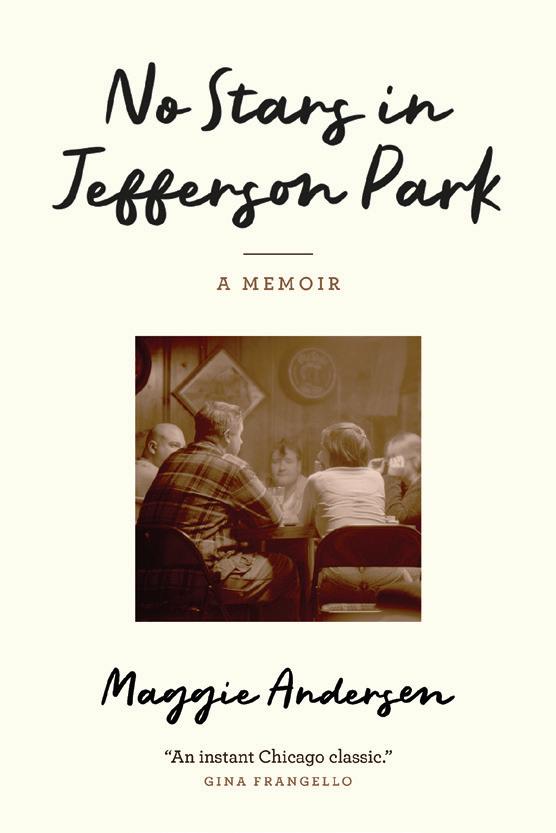
Andersen was there for part of Thornton’s journey. But her memoir is really about trying to find her own voice and identity apart from the supportive-partner role for which she never auditioned, and which she eventually abandoned, along with acting (she remains a member of the Gift ensemble, however).
She left Thornton and Chicago twice after his health crisis: once to attend a writing workshop in Prague in 2004, where she had an a air with a fellow student, and then for an MFA program at Western Michigan University, where she studied with fellow working-class Chicagoan Stuart Dybek. She now teaches English at River Forest’s Dominican University. MEMOIR
release from rehab, Thornton and Andersen moved from their apartment into his parents’ house. Andersen uses the format of dramatic dialogue to recount the night of their final breakup in his parents’ backyard, including the o stage voices of Thornton’s mom, Rita, and a neighbor loudly worrying about what they’d do if one of their kids got sick. “I pray, I go to church, I’m a good person, but so is Rita.”
Catholic guilt is a component of the story that Andersen is telling, along with the “stand by your man” assumptions that others made about what her role in Thornton’s life would be going forward. “We broke up, in part, because I needed to tell the truth now to survive, and Mike still needed imagination,” Andersen writes. She tells that truth with gimlet-eyed clarity, compassion, and love for her family, Thornton and his family, and their creative
acquiescing word, the end of resistance, and maybe that’s why I had stopped saying it.” By saying “no” to one narrow path that was thrust upon her and Thornton, Andersen’s memoir shows that there are other roads waiting and other ways ahead. She and Thornton have both found new partners; they are still friends, and the actor has found even more success after his stroke than he had before (he currently stars on Broadway as Lucky in Samuel Beckett’s Waiting for Godot alongside Keanu Reeves and Alex Winter). No Stars in Jefferson Park is an important snapshot of a particular era in Chicago theater. It’s more important as a warm and unwavering portrait of overcoming the guilt of claiming your life as your gift. v
m
kreid@chicagoreader.com
Maggie Andersen
L: CLAIRE DEMOS; COVER PHOTO BY KENNY MIHLFRIED, DESIGN BY LAUREN MICHELLE SMITH
ANDREA CARLSON: A CONSTANT SKY edited by Dakota Hoska Rizzoli, paperback, 128 pp., $ 35, rizzoliusa.com/book/9781785515941
MONOGRAPH
Where shore meets horizon
Andrea Carlson: A Constant Sky compiles 20 years of the artist’s paintings.
By SHIRA FRIEDMAN-PARKS
“Shores make imagining and scrying possible,” artist Andrea Carlson wrote for Fett magazine in 2018. This fall, her debut monograph, Andrea Carlson: A Constant Sky , compiles 20 years of her painting, looking across the horizon. An artistic force to be reckoned with, Carlson works between Chicago and northern Minnesota. Her multipanel, multimedium works compile cannibal film narratives, museum dissonance, and Indigenous Futurisms into vivid, cultural iconography–filled landscapes. She’s also a cofounder of Chicago’s Center for Native Futures: “within the adversarial context of all that teaches us to desire colonization . . . [it’s] one of these soft, joy-filled spaces,” she writes.
Andrea Carlson: A Constant Sky was published to coincide with the artist’s upcoming solo exhibition of the same name at the Denver Art Museum. There, her in-production largescale painting The Constant Sky (2025) will complete the three-part series that began with Ink Babel (2014) and Red Exit (2020). Each measuring 115 x 183 inches, these intricate landscape-based works mimic the repetition and motion of celluloid filmstrips. “I’m interested in land as an extension of how we organize information and how information moves on a sphere or torus as an infinite space,” she writes. “The cells also make it hard to imagine entering the landscape without the viewer being fragmented themselves.”
The book begins by charting Carlson’s body of work and media inspirations, working its way up from 2005. Interspersing Carlson’s elaborate, colorful complete works and much-
BOOKS

appreciated detail shots are essays, poems by Heid E. Erdrich, and an extended conversation between Carlson and curator Dakota Hoska.
Where shore meets horizon is a through line across Carlson’s work: a way of imagining past, present, and future converging in space; or, “to gaze and to dream and to daydream,” as Nasrin Himada writes. The shoreline is the foundation through which Carlson tells her stories. “In most of my work, the imagery tends to be washed up on its own shore,” she writes. “Simply put, it’s all Lake Superior to me, but it could be any large body of water.”
Readers from Chicago may see a familiar horizon, Lake Michigan.
Beyond negating a plane ticket to Denver, the physical object of the book gets at the materiality of paper in Carlson’s work as a whole.
Her painted works are created on panels of paper, rather than canvas, where the imperfect edges often poke through. Paper surfaces are
intentionally incorporated into works such as The Tempest (2008), Ancestor and Descendant (2023), and the VORE series. “To talk about paper, I must talk about landscape,” Carlson writes. “If we consider the political and legal structures of the dispossession of Indigenous people, paper serves a function against us and the land. It provides a thin cover through deeds, bills of sale, maps, and treaties that all describe the land, abstract the land, and provide legal cover for the theft of land.”
In her essay, art journalist Aruna D’Souza lingers on VORE, Carlson’s longest-running series. VORE draws upon imagery and language from Italian cannibal exploitation films of the 70s and 80s. In it, Carlson explores the irony of barbarity narratives created about Indigenous people by colonizers and by filmmakers for viewers craving sensationalism from their couch.
Citing Michel Foucault, VORE considers how
film rewrites history to impose frameworks on the present, and furthermore, how museums practice a cannibalism of their own. “Museums also have this sickness,” Carlson writes. “They are hungry, they often misidentify what they consume, and they assimilate things outside of themselves.” In VORE, all pieces share the same horizon line; beside each other, the shore continues towards infinity.
Erdrich recalls stories of the Wiindigo, an insatiable, cannibal creature. “I like to think the girl was the first person to figure out how to slay the monster,” she writes. “I like to see similar gambles and tricks at work in Andrea Carlson’s paintings and films that say that no matter how hungry you are, you will not eat us. We will eat everything we see and o er it back to you, in exquisitely rendered detail, but you will not eat us in the end.” v
Andrea Carlson, Cannibal Ferox, 2008 © ANDREA CARLSON
ZINE FEST
‘Meet nice people who make art’
The goal of Pretty Good Fest is to get some form of art into everybody’s hands.
By SAVANNAH HUGUELEY
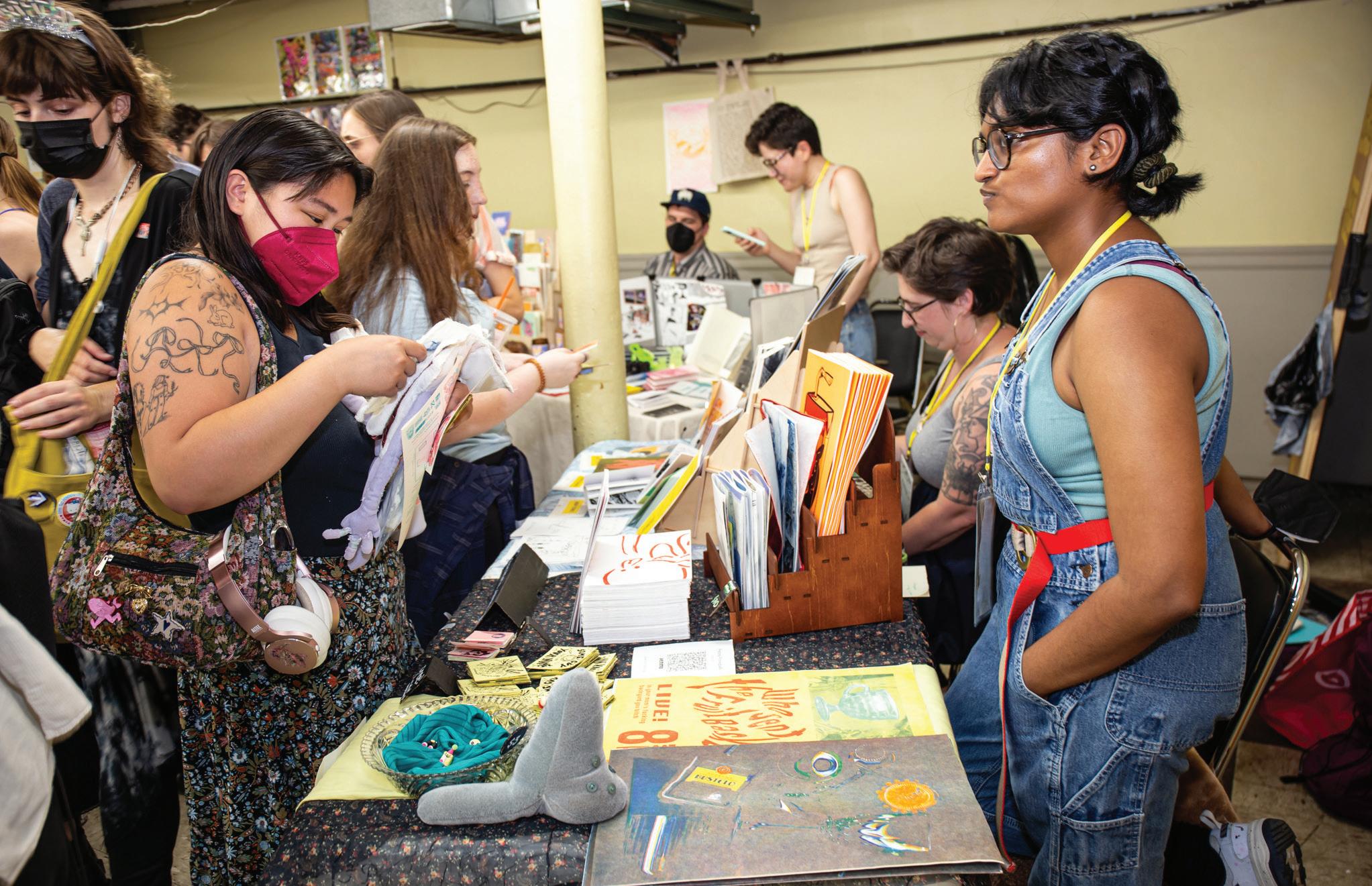
Pretty Good Fest, a new comics and small press fair, is debuting in the city this fall. Hosted on Saturday, October 4, at the Chicago Athletic Hotel from 11 AM to 6 PM, the fest will bring together over one hundred artists, cartoonists, zinemakers, and small publishers from across Chicago, the midwest, and the country.
Pretty Good Fest is a sort of successor to last year’s slightly smaller but just as impactful Zine Not Dead Fest, which built off the almost-decade-old comics reading series of the same name. While last year’s festival operated off of a DCASE grant, this new fair is sponsored by arts organizations Lumpen, Quimby’s, and Howling Pages—who will all be vending their creators’ work. It also di ers in that organizers held a lottery for around 25 percent of the exhibitor spots, as a way to keep the fair accessible to emerging artists.
Matt Davis and a number of other people involved in last year’s fest wanted to bring together artists and makers again. “More than anything, I’m interested in building community and connecting seemingly disparate practices and seeing where collaboration takes people,” said Davis, who has run his own Pilsen-based risograph printer and publisher, Perfectly Acceptable Press, since 2013. Chicago-based exhibitors include comic artist, illustrator, and Punk Rock Karaoke author Bianca Xunise; graphic artist CHema Skandal!; ZINEmercado, another zine fest that just celebrated its tenth anniversary; artist, printmaker, and educator Atlan Arceo-Witzl and his project Tenoch Press; and many more. Among those coming to Chicago for the event are California-based book illustrator Ann Xu; Minneapolis-based queer- and trans-run micropress Late Night Copies Press; and Seattle-based

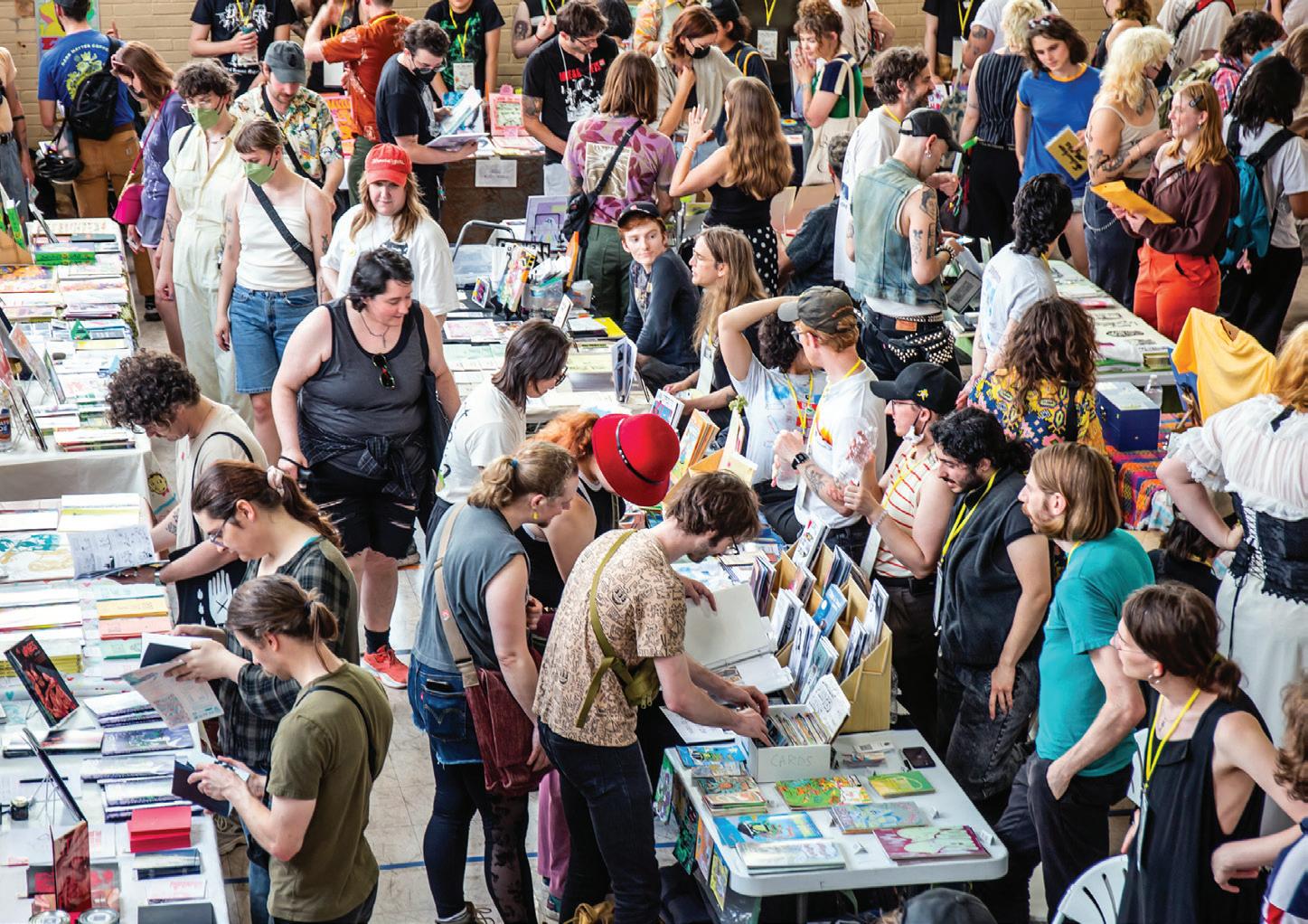
risograph publisher Living Room Press.
Exhibitors will be selling their prints, comics, and artist books across two floors of the hotel. Davis assured me that nothing at the fair is going to be very expensive—the goal is to get some form of art into everybody’s hands.
At its core, Pretty Good Fest is a “way to meet nice people who make art,” said Davis, and, in that spirit, it will end with an afterparty and comics reading on the hotel’s first floor beginning at 8:30 PM. v m shugueley@chicagoreader.com
Visitors and vendors at 2024’s Zine Not Dead Fest GLITTERGUTS/ERIC STROM
RThrough 10/ 12: Wed–Fri 7:30 PM, Sat–Sun 2 and 7:30 PM; ASL interpretation, audio description, and touch tour Sat 10/4 2 PM (touch tour 12:30 PM), open captions Sun 10/5 2 PM; Court Theatre, 5535 S. Ellis, 773 -753 - 4472 , courttheatre.org, $22-$94
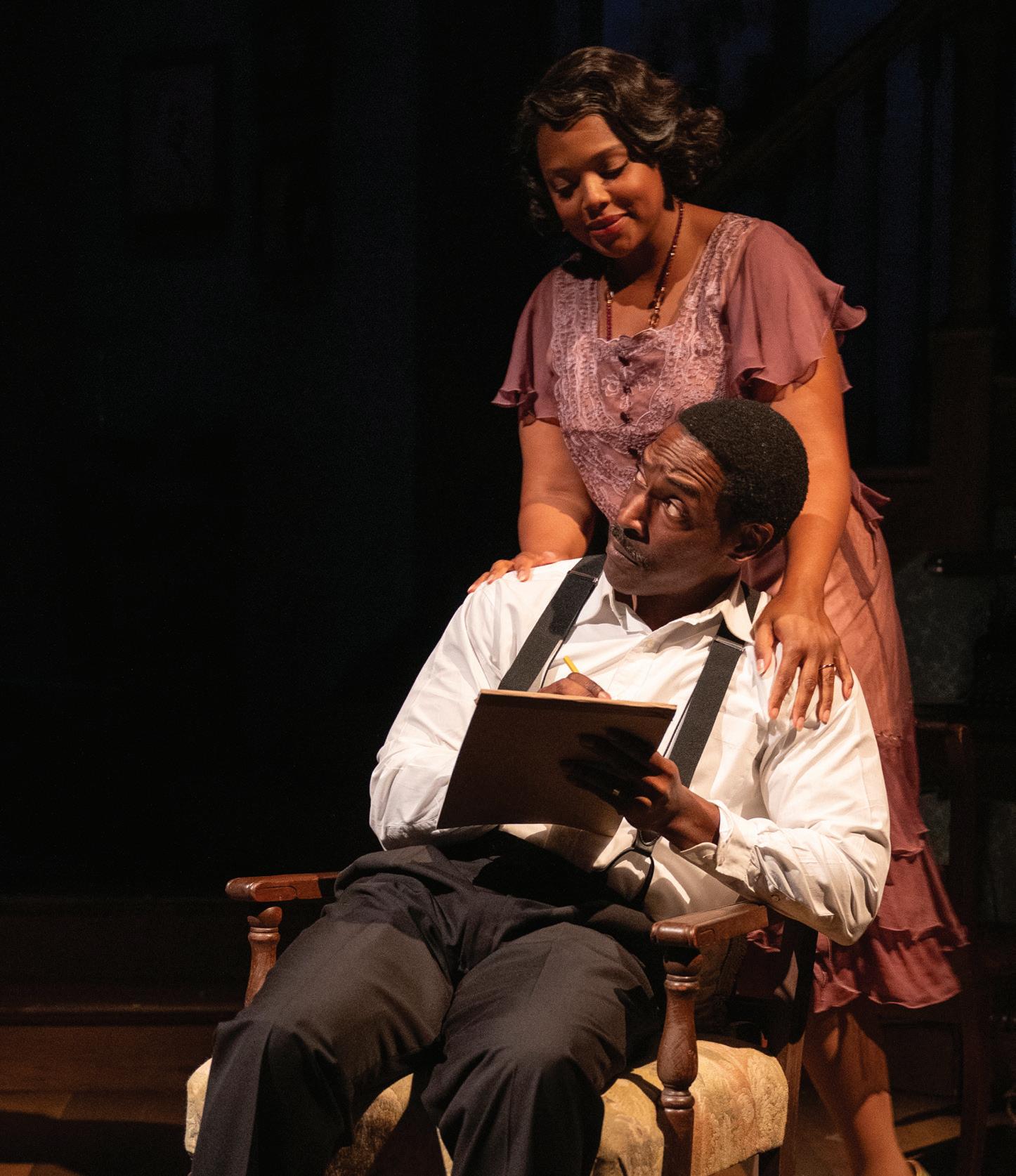
IBig White Fog gets a stellar revival at Court Theatre
Theodore Ward’s landmark play about a Black south-side family finally comes home.
By KERRY REID
n Mark Larson’s 2019 book Ensemble: An Oral History of Chicago Theater, longtime Chicago theatermaker Pemon Rami, founder of the influential La Mont Zeno Theatre, tells Larson that Chicago playwright Theodore Ward “is considered the godfather of black theater in this country,” and cites his work cofounding the Negro Unit of the Federal Theatre Project with Langston Hughes, Paul Robeson, and Richard Wright during the Depression. Ward, who was born in Louisiana and knocked around a few places before settling in Chicago in 1933, was the first Black dramatist to receive a Guggenheim Fellowship. (He used it to write John Brown, based on the life of the abolitionist and staged in Chicago in 1951.) He was also a member of the South Side Writers Group, alongside other luminaries of Black American literature such as Wright, Arna Bontemps, and Margaret Walker. When I was a student at Columbia College Chicago, the
school instituted the Theodore Ward Prize for Black Playwrights, beginning in 1987 with Christopher Moore’s The Last Season
But in all likelihood, like me, you’ve never seen a production of one of Ward’s plays. Court Theatre’s stirring revival of Ward’s landmark 1938 drama, Big White Fog, directed by Ron OJ Parson, makes the case for why that’s a shame, and why Ward’s work deserves fresh eyes and audiences in the 21st century.
Set in an apartment building on South Dearborn in Washington Park, the play unfolds between 1922 and 1932, tracing the decline in fortunes of the Mason family. Father Victor (Joshua L. Green), a disciple of Black nationalist and pan-Africanist Marcus Garvey, dreams of taking his family to Africa with other Garveyites. His wife, Ella (Sharriese Hamilton), is supportive to a point, but still wants their children to stay in the U.S. and finish school. Eldest son Les (Patrick Newson Jr.) is eagerly
awaiting word on a scholarship to study chemistry at a university, while eldest daughter Wanda (Ayanna Bria Bakari) wants to drop out of high school and go to work at a drugstore, like her “fast” friend, Claudine (Saran Bakari). “I’ve as much right to nice things as anyone else. If I go to work, I can get them,” she tells her mother.
By contrast, Ella’s sister, Juanita (Alanna Lovely), and brother-in-law, Daniel (Amir Abdullah), plan to make their fortunes in real estate by chopping up a six-flat building into 40 tiny “kitchenettes” to exploit the Black people who’ve moved north and can’t find housing. Daniel and Juanita both needle Ella and Victor about putting their faith and money in Garvey’s movement instead of making money the way the white folks do. “You don’t see any of our really big people falling for Marcus Garvey’s jive, do you?” Juanita asks Ella. But Victor’s support of Garvey remains tragically steadfast.
Ward’s play touches on a host of issues that were later further amplified by dramatists such as Lorraine Hansberry and August Wilson. The conflict over how and where Black people should invest their money in order to build a future is central to Hansberry’s A Raisin in the Sun (produced by Court in February and directed by Parson at TimeLine in 2013).
Sure, Victor’s ideals are loftier than Walter Lee Younger’s plans to open a liquor store. But he’s no less susceptible to con artists than Walter. (Jack Magaw’s beautifully realized period set includes a small yellowing fern on the window seat, which to me felt like a deliberate allusion to Lena Younger’s symbolic house plant in Raisin .) Victor’s brother, Percy (Ronald L. Conner), is a hard-drinking World War I vet with PTSD who, like so many returning Black vets, was attacked by white men while still in uniform. He feels like a forerunner to the damaged but insightful Black men who haunt the edges of Wilson’s plays, like Troy Maxson’s brother, Gabriel, in Fences or Hambone in Two Trains Running.
Ward’s play also taps into the restless revolutionary spirit of the 1920s and ’30s, not just through the ideology of Garvey but through communism. Lester, denied a scholarship because he’s Black, goes to work for his uncle Daniel, but soon becomes enmeshed in leftist politics, in part through his Jewish friend, Nathan (Artem Kreimer).
As the years go on and times get tougher, Ella’s devotion to her husband is strained as
THEATER
he increasingly puts his idealism ahead of the material needs of his family. “I’ve been a woman and a wife to you. But I’m through with you! You hear me? I’m through with you!” she tells Victor at one point, reminiscent of Fences’s Rose Maxson telling Troy, “You a womanless man.” Victor, unlike Troy, isn’t unfaithful to his vows. But Victor’s dreams (not merely deferred, but killed by Garvey’s fraud around his Black Star Line) aren’t enough to sustain his family, especially as the Depression hits in the second act.
This is where Big White Fog goes into Clifford Odets territory (without giving spoilers, the ending does have some echoes of Odets’s 1935 labor classic, Waiting for Lefty). But Ward knew how to use multiple lenses to view the inequalities of the time, which sustains the story even when it slides a bit toward the didactic or melodramatic in the second act. When Nathan tells Les, “The lasting solution for minority groups today is unity with the majority on a common ground,” there are echoes of any number of contemporary class-over-race advocates (many of whom, conveniently, happen to be white). And the burdens placed on Black women in maintaining homes and families through thick and thin come through clearly in the sacrifices made by both Ella and Wanda— the latter making the hardest decision in order to help out the family.
But Ward also clearly loves these characters, carefully capturing the family and intraracial dynamics in the world of the play, which often come through in humorous interludes as well as more fraught confrontations. Greta Oglesby as Martha Brooks, mother of Ella and Juanita, provides both comic relief in her bluntness and a snapshot of colorism as she talks about her Dupree blood—that is, the part of her lineage that’s white. Vic tells her, “You envy my Black skin because in your heart, you know yours is nothing but a badge of shame.” But Martha also makes the case for standing your ground and fighting in your own country as part of your birthright.
The play’s title comes from a speech Les makes after being denied his scholarship. “Seems like the world ain’t nothing but a big white fog, and we can’t see no light nowhere.” Ward’s sharply realized portrait of a Black family in crisis on multiple fronts largely succeeds on both personal and political grounds, and Parson’s stellar ensemble helps us cut through the fog of history to see how much it resonates today. v
m kreid@chicagoreader.com
Sharriese Hamilton (top) and Joshua L. Green in Big White Fog at Court Theatre
MICHAEL BROSILOW


ASHLAND AVENUE
BY LEE KIRK DIRECTED BY SUSAN V. BOOTH
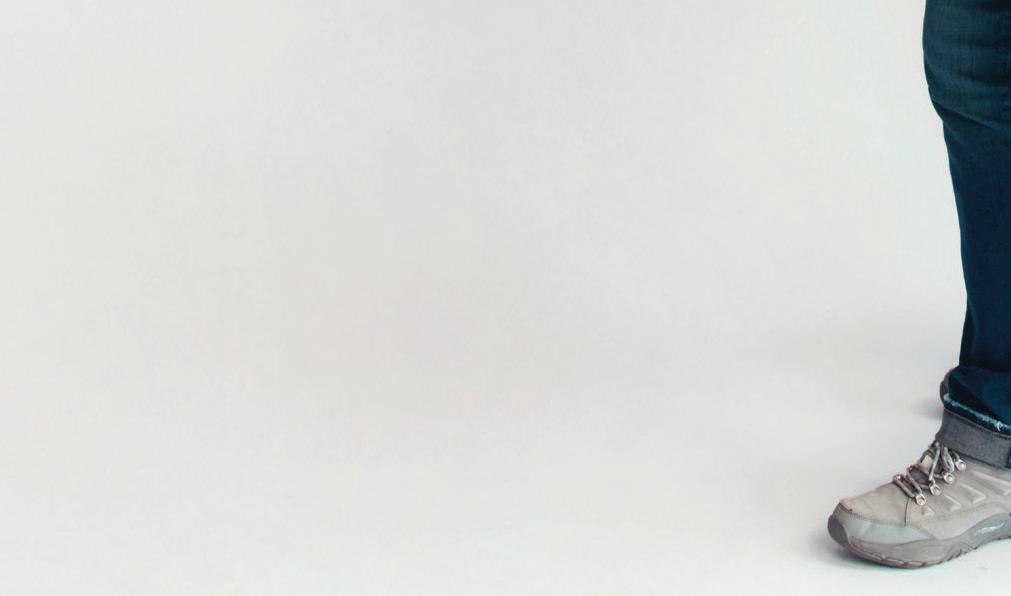



THEATER

OPENING
RThe sins of the fathers
Gangsta Baby is a harsh but heartfelt look at generational trauma and toxic masculinity.
Cameron Raasdal-Munro gives himself and the audience a workout in his semi-autobiographical play, Gangsta Baby, before the show even begins. As the audience files into the tiny Open Space Arts venue, Raasdal-Munro is shadow boxing and doing push-ups. The exercising is a hint of the exorcising that takes place in the play, based on his experiences growing up queer in the coastal city of Hastings in the UK with a mobster father. That father, called Senior in the play, was also primarily attracted to men—a source of genuine comfort and joy to him, alongside the shame and loss he endured at the hands of his father.
Adroitly directed by Rikki Beadle-Blair, this U.S. premiere gives us no place to look away as the harsh violence enacted by Josh Odor’s Senior takes its toll on Raasdal-Munro’s Junior (who makes his living as a sex worker) and Junior’s trans stepbrother, Pete (a splendid Jensen Knudsen). Junior’s client, Mitch (Bryan Nicholas Carter), engages in role-play with Junior. Both suffered under the thumb of school bullies (Junior
in part because of his dyslexia, which Pete tries to help him overcome).
At the start of the show, Junior makes suggestive comments to us as if we’re potential customers, asks an audience member for a “safe word,” and distributes coins for tips that will be collected later on in the story. But even if the fourth wall remained firmly in place in Gangsta Baby, the story is so compelling in its haunting pain and sharply delineated portrait of generational trauma that we feel a part of Junior’s story.
In some ways, Raasdal-Munro’s play also feels like it shares DNA with the 1990s “in-yer-face” school of British theater, represented by plays like Mark Ravenhill’s 1996 drama Shopping and Fucking and the work of the late Sarah Kane. But the hardest scenes to watch in this production aren’t necessarily the ones with the most violence (though both R&D Choreography’s violence design and Christa Retka’s intimacy coordination deserve praise for working so well in such tight quarters). There’s no safe place to hide in Junior’s world. But perhaps it’s appropriate that Raasdal-Munro himself has found a place of healing by turning his family history of toxic masculinity into a wholly absorbing and thoughtful piece of soul-searching and visceral theater. —KERRY REID GANGSTA BABY Through 10/19: Fri-Sat 7:30 PM, Sun 2 PM; also Thu 10/16 7:30 PM; Open Space Arts, 1411 W. Wilson, openspacearts.org, $30 ($25 students/seniors) v
Josh Odor (L) and Cameron Raasdal-Munro in Gangsta Baby at Open Space Arts TADHG MITCHEL

Chase Infiniti is Chicago’s latest claim to fame
The young actor and Columbia College Chicago graduate makes her feature film debut in One Battle A er Another.
By ZACHARY LEE
To borrow some words from the book of Ephesians, director Paul Thomas Anderson’s One Battle After Another (2025) reminds us that we battle not just against “flesh and blood” but against “rulers, authorities, the cosmic powers of this present darkness, and the spiritual forces of evil in the heavenly places.”
It’s a film that reiterates that the struggle against hatred, bigotry, and racism is not new; these ancient struggles have merely taken on new, pernicious forms. Those with such malignant worldviews hold political o ce, control market forces and industries with great sway, and think that it’s far better to erase and reshape history than to face it.
The fight hasn’t changed, but the revolutionaries have to adapt, and that’s the launch-
ing point for Anderson’s riveting film, which is kinetic in momentum and horrific in its prescience. A loose adaptation of Thomas Pynchon’s 1990 book, Vineland, the crux of the film focuses on Bob Ferguson (Leonardo DiCaprio) and his daughter, Willa (Chase Infiniti). Willa has never known her mother, Perfidia Beverly Hills (a live-wire Teyana Taylor), who was part of the revolutionary group known as the French 75 alongside Bob. The group’s nemesis, Colonel Steven J. Lockjaw (Sean Penn), armed with the “embrace of the federal government” (read: an armed private militia that he can command to storm any town he chooses), remains obsessed with Bob and Willa and descends upon their hometown to capture them. This marks the feature film debut for Infiniti, and she brings an incendiary steeliness
and iconoclastic resolve to Willa, who realizes that her parents’ struggles for independence and freedom are now her own. Infiniti studied musical theater at Columbia College Chicago and graduated with a BFA in 2022. She credits Chicago as formative in her portrayal of Willa, sharing how the support network of friends, peers, and professors provided a strong foundation for her to take on roles that put her outside of her comfort zone. She cites Chicagoans’ overall knack for building community and protecting the found family as another touchstone of inspiration.
On a phone call, Infiniti spoke more about how Chicago shaped her as an artist, the significance of wardrobe in building a character, and how a local dance collective prepared her for the film’s stunt-heavy sequences.
This conversation has been edited for length and clarity. It contains mild spoilers for One Battle After Another.
Zachary Lee: It was a joy to learn that you cofounded the Chicago-based dance collective Duple Dance Crew. How did that dancing background aid you not only in doing the film’s vehicular stunts but also as you learned karate and mixed martial arts?
Chase Infiniti: It definitely all helped. I went to school for musical theater, and so I am familiar with moving my body in a space, but I was also a kickboxing fitness instructor. Dance helped me be aware of the demands of all types of choreography, but it also taught me to keep myself as safe as possible while I was moving. Kickboxing helped ensure I embody the physicality and intensity of someone like Willa, who is amazing at karate and could handle her own in her fight.
It’s not that other characters don’t have to drive or shoot or run, but you do most—if not all—of those actions while zip-tied and in a skirt.
Truthfully, on day one, I was just like, “Just put the handcu s on me. Let’s try one take.” I wanted to go for it, but in the back of my mind, I was also thinking about “let me not twist my arm o or break my leg.” That’s in some part what Willa is thinking in those scenes, but she can’t let it show. But for me, for the most part, during the days of shooting, if there was a hiccup, Paul, the rest of the crew, and I would work out those hiccups. I just kind of went at it. [Laughs.]
Willa’s wardrobe doesn’t change much throughout this film. You’re wearing your leather jacket, blue skirt, and boots for most scenes. Can you talk about working with costume designer Colleen Atwood to craft Willa’s wardrobe, and also how you viewed the outfit as a way to understand your character’s interiority?
I love that question. Getting to work with Colleen Atwood, who is a legend in and of herself, was incredible because she has such an amazing mind. She and Paul created Willa as a whole through her costume, so every piece was very intentional. Colleen and I tried on so many di erent varieties, not just of the skirt
FILM
continued from p. 15
but even the combination of di erent fits. We did just a dress, we did a version with a dress and a jacket, before settling on the jacket, T-shirt, and skirt. We also tried on so many di erent varieties of the boots.
The extra cherry on top—which, I don’t know if anyone clocked it or not—was that in the moment where I’m firing the gun at the hideout of the Sisters of the Beaver, Willa is wearing the same combat boots that Perfidia is wearing when she’s firing the gun, being nine months pregnant with Willa. I didn’t even know that at the top, but when I saw that sequence, it made me feel even more love for Willa because she’s surrounded by her mother, even though she doesn’t know her in that moment.
She’s never felt closer to her mother than when she’s on those same lands, firing a rifle. It’s also striking to note the difference in facial expressions you two share: You’re stoic and controlled, while Teyana played it more unvarnished and with abandon.
Playing into that contrast came from conversations with Paul, and the two of us collaborating on how we were both viewing Willa’s storyline at that moment. In that moment when you meet Willa, she’s in this intense headspace where she’s in an unfamiliar area and she feels out of her comfort zone. But one thing Willa knows how to do is fire a gun and fight. I got to see the playback because someone recorded it from the side. I hadn’t at that point seen how Teyana was shooting her version of that scene. Getting to see them contrasted and mirrored like that was striking and epic.
It’s a film of intense facial expressions. You, in particular, have many confrontations with Leonardo DiCaprio and Sean Penn. I’m curious if your preparation differs when you know the camera will be capturing every detail of your face for those close-ups, where the audience can see everything.
Teyana, Regina [Hall], and I were actually talking about this. The crazy part is that while filming, the camera doesn’t feel like it’s that close on you. I think to your point, though, the beauty is that you can’t hide anything. You get great insight into how Willa and the characters are feeling in a given moment just by what we have to communicate on our faces. The closeup on me and Sean when we’re having our confrontation and the two are sussing each
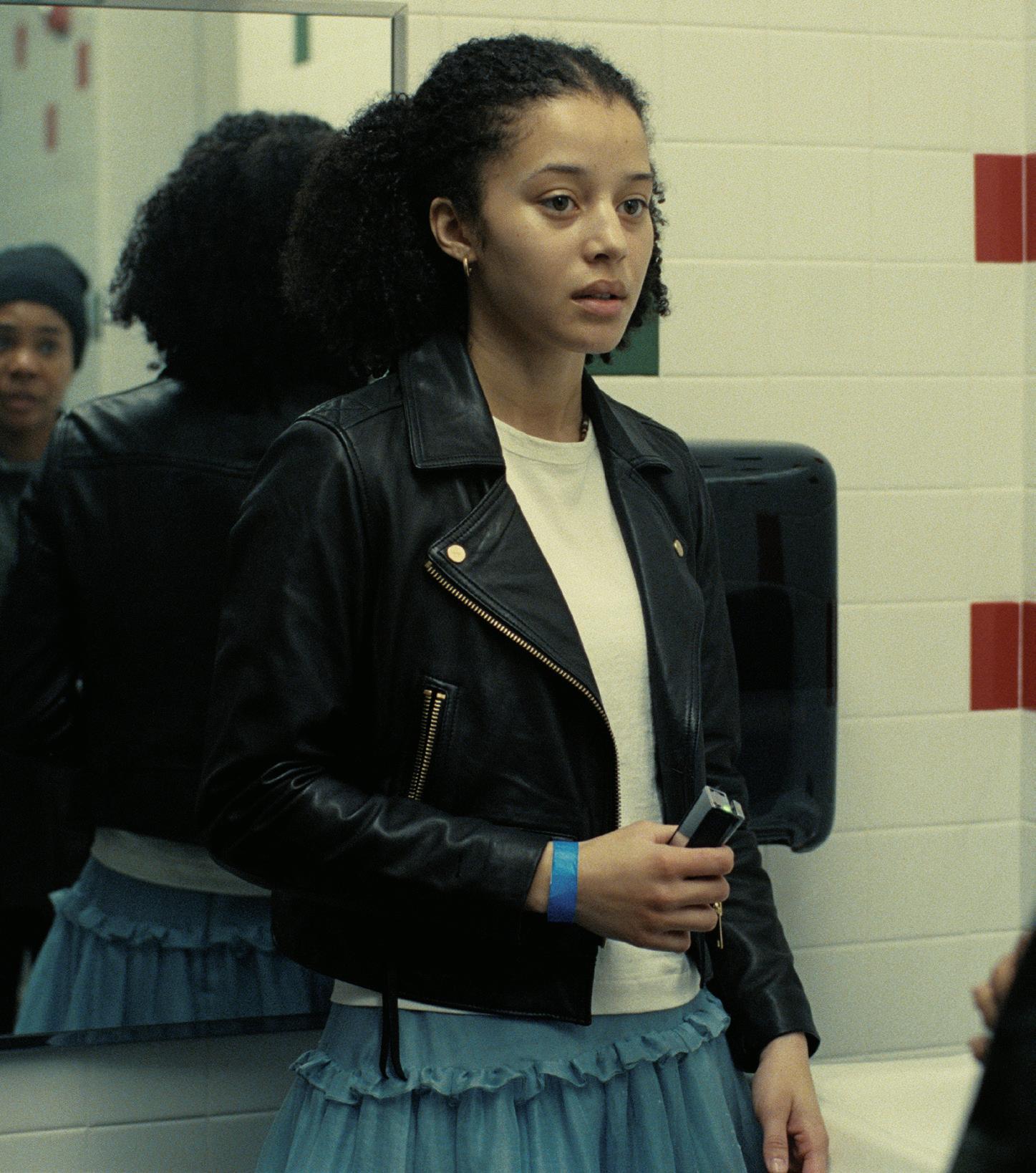
other out . . . it’s insane because we couldn’t hide anything. All of our complex emotions are laid bare in little subtleties. Those extreme close-ups o er you so much opportunity for honesty as an actor.
I also think of the scene with Regina at the end, where she’s bearing the weight of the decision she has to make. It breaks my heart, and I think it’s so e ective because the camera is so close and you see Regina process all the emotions of her character in real time.
We’ve talked a lot about how Willa, the character, has had to come of age, but I’m curious about your formation: Can you speak more to the role Chicago has played in your creative life?
Chicago is the first city that I truly fell in love with, and I love it so much to this day.
that were touchpoints for you to embody someone like Willa?
More than anything, I’m grateful for the professors at Columbia and my friends who poured a lot of advice and empowerment into me. That support network gave me the strength to push myself in ways I hadn’t done before. I felt grateful that I could bring that sense of confidence into Paul’s set, where he encouraged the opportunity to play, build, and learn. Everyone I worked with encouraged me to explore the limits and push myself in ways that I’d never believed before.
The opening of the film, where we see the French 75 free migrants from ICE facilities, struck a particularly painful chord. I think of the ways communities in Chicago have rallied against those forces that seek to rip families apart. I’m curious how coming from Chicago may have shaped you as an activist and artist or how it might have prepared you to work on a project like this that’s so pointedly commenting on what’s going on in our world right now.
It’s crazy because Paul started working on this movie 20 years ago. That’s a painful testament that he’s worked on this for so long, and it’s still just as relevant. I think at the heart of our story, you see true love and true community, and how far somebody will go for the ones that they love. One of the things I love about Chicago is that there’s so much love in that city, and you feel it in the communities. People fiercely care, and witnessing that solidarity has impacted me.
I hope you catch a screening of the film over at the Music Box; it’s showing in 70 mm there.
I’m grateful to call it my home, and I remember falling in love with it when I first went to Columbia because it was a city that was so rich in culture and community. Yes, the winters are harsh, but it makes up for it through the warmth of its people. There’s something there for everybody, and you really see people come together beautifully; people blossom in the summer, and the city feels like it’s in bloom then. There’s a magic there that inspires me, and I never want to leave.
One of your biggest roles has been on the Apple TV+ drama Presumed Innocent, but I’m also wondering if there was a role from any productions you did while at Columbia
In the first scene of the film, Sensei tells Willa to breathe. It feels like a grace note before the ensuing calamity. Do you feel like you’re still mastering what it means to “breathe” in the midst of experiencing the world in all its craziness and horrors?
I think that one of the most powerful things that you can do as a person, especially in moments of high intensity and high anxiety, is to breathe; it’s so easy to forget. It’s only when I actually started implementing [intentional breathing] that I realized that, as hard as it is to do in the midst of the storm, it’s how you find strength amidst constant movement. I’m trying to remember to take those moments of stillness to find the strength and empowerment to keep pushing forward. v
m letters@chicagoreader.com
Infi niti works alongside Leonardo DiCaprio and other stars in Paul Thomas Anderson’s latest. COURTESY WARNER BROS. PICTURES



In Alexander Horwath’s formidable three-hour essay film, Henry Fonda for President (2024), which screened this weekend as part of the Chicago Underground Film Festival (CUFF), Horwath notices among the great actor’s performances his propensity for putting his hand over his face, be it to hide a character’s shame or, more curiously, his pride. Horwath connects the action to more than just the archetypes for which Fonda is best known, as a man on the run, at odds with society’s expectations and thus in hiding from its inculcation, or one seeking justice—or perhaps both, as is epitomized in John Ford’s The Grapes of Wrath (1940). He also connects the motion to the actor himself, a complicated figure with comparatively low self-esteem in spite of his extraordinary accomplishments. “Self-reflection and doubt,” exclaims Horwath in voiceover, “they prevent him from succumbing to tears and triumphalism, even if the rest of the world regards him as a king.”
On the other hand (pun intended), you have someone like Leni Riefenstahl, the German actress and director of such Nazi propaganda films as Triumph of the Will (1935) and Olympia (1938); the new documentary about her, Andres Veiel’s Riefenstahl (2024), played at the Siskel Film Center this week. It’s less a biographical exploration and more an investigation into Riefenstahl’s complicity as a known “fellow traveler” of Hitler and his regime, one who nevertheless denied knowing anything about the extreme horrors of the Holocaust despite evidence to the contrary. To be frank, I would have appreciated more of a focus on Riefenstahl as a filmmaker, as in my mind her complicity isn’t something anyone needs to prove—it seems quite obvious. But my colleague Dmitry Samarov, in his review of the film for the Reader, makes a good point about it being reminiscent of something all too familiar nowadays, which is people “doubling and tripling down on obvious falsehoods and, rather than being
FILM
(2024)

shunned, being rewarded for it,” the latter referring to the great number of people who continued to admire Riefenstahl despite her moral failings. But in terms of actual hands, I thought about both high-profile figures in connection to one another. A photo following the war depicts Riefenstahl holding her hands out in front of her, presumably to push away whoever’s trying to take her picture. Fonda covered his face to hide what he was feeling, suggesting an intensity he wanted to conceal lest emotions be taken for granted, while Riefenstahl was actively pushing people away from the truth. I also wrote a few weeks ago about the importance of cinema to culture, and both figures and much of their output are perfect examples of that. Horwath specifically charts Fonda’s life and career against the times in which he lived, revealing how he reflected back that of which he was part, while Riefenstahl fueled a propaganda machine, her acute technical skill utilized in part to make fascism look alluring.
Otherwise, I spent much of my moviegoing at CUFF, which, in my estimation, had an exceptional year. Among the shorts I saw and enjoyed were Carlo Nasisse’s Animal Eye (2025), about the vision of animals; Miranda Siegel’s Ignore Your True Feelings at Your Own Peril (2024), in which Siegel records herself vomiting over several weeks following a bipolar episode, set to an irreverent earworm of a score; Mark Street’s all day, and all of the night (2025), a ruminative urban anagoge; and Kelly Sears’s The Call (2025), a clever speculation in which birds take a stand against their man-made aerial adversaries. Festival season is upon us, and thus far it’s going well!
Until next time, moviegoers. —KAT SACHS v
The Moviegoer is the diary of a local film bu , collecting the best of what Chicago’s independent and underground film scene has to o er.
REVOLUTION(S)
BY ZAYD AYERS DOHRN
MUSIC AND LYRICS BY TOM MORELLO DIRECTED BY STEVE H. BROADNAX III

When soldier and aspiring musician Hampton Weems comes home from Afghanistan, he finds the South Side of Chicago is also occupied territory—and he’s accidentally joined the resistance. This all-new radical musical event from Rock and Roll Hall of Famer Tom Morello (Rage Against the Machine, Audioslave and The Nightwatchman) and Chicago’s own Zayd Ayers Dohrn pulses with punk, hip-hop and metal, and celebrates the courage that inspires us—across generations—to demand a better world.
STARTS OCTOBER 4
MUSIC

In February, Isaac Delgado went to a Pilsen punk show benefiting immigrant resource organizations. The show’s organizers, Ruidosa Art Collective, have hosted literary events, a meetup for making protest posters, markets for visual artists, and concerts that spotlight Chicago Latine culture. Isaac loves Ruidosa’s mission and had been following the group online for a couple years, but that February gig was the first time he’d made it to one of their events. He wanted to support the fight against the second Trump regime’s racist demonization of his community. He also liked the lineup: The five-band bill was full of vital new Chicago hardcore bands, most notably Snu ed and Si Dios Quiere.
“I think punk gives a great way to express any resentment you have towards what’s going on in life, without hurting anyone,” Isaac says. “It’s a very healthy way to express your emotions.” In fall 2024, he’d started playing in a punk band of his own: Mictlan, who
Pancho’s parents moved separately to the U.S. from Mexico. His mom grew up in the state of Morelos; his father, in Guanajuato. They met at a Chicago grocery store where his father worked, and Pancho is the fourth of their eight children. When he was eight, an uncle gave him a copy of the 2006 video game Guitar Hero II, which introduced him to Black Sabbath and other early favorites.
He developed his taste through emo, which led him to the wider world of Warped Tour. From there, in the mid-2010s, he found Kentucky hardcore favorites Knocked Loose.
MOshIng aNd MakIng frIenDs MOshIng aNd MakIng frIenDs
take their name from the Aztec underworld.
At the Ruidosa show, he met Francisco “Pancho” García, who’d cofounded the collective. Pancho has been organizing punk shows for a few years, and he was on the bill with his band Los Skin.
“Once you’re in the scene, you realize a lot of shows are hard to get, and DIY spaces in particular are hard to find because everything closes down,” says Si Dios Quiere bassist Louie Flores. “[Pancho] came in, like, ‘Yo, I got a connection for this spot and that spot.’ He was very helpful, getting places for bands. A lot of people found out who he was, ’cause it’s like, ‘This guy’s throwing shows and finding all these spaces.’”
One of those spaces is the DIY venue that hosted Ruidosa’s February fundraising concert. The collective raised $3,000; the proceeds went to three organizations, including the National Immigrant Justice Center and Chicago-based advocacy group Mujeres
Latinas en Acción. “A lot of my community was there,” Isaac says. “Seeing how many people showed up and what the bands were saying between the songs—how many of their parents came here, only to work. They’re not criminals. They’re just people looking for a better future. That’s something I’ve always felt myself.”
Isaac wanted to be part of the scene, and not just as a spectator—he wanted Mictlan to play. He got his wish in August, when Mictlan made their full-band debut in the backroom of Pilsen taco joint Casa Cafe. They were the first of seven bands at a hardcore spectacular anchored by Illinois scene heavyweights Prevention and Payasa. Their booker? Pancho.
“That’s what I try to do every show now: try to put on a new band, a young band, and put them onto this sick gig so they can keep playing shows,” Pancho says. He wants to show them that “you just have to reach out and get involved.”
By LEOR GALIL
“I was like, ‘This is the heavy kinda music I wanna play,’” Pancho says. “They helped me understand hardcore.” He started playing guitar in the late 2010s, teaching himself with help from online how-to videos. “I was like, ‘I didn’t know music was that simple,’” he says. “I looked up my favorite songs and learned them. I started practicing all the time, wanting to get better, wanting to start a band.” Pancho recruited his youngest sister, Stacy, to play drums, and they called their band Los Skin. They made their live debut in 2021.
Around the same time, Pancho discovered the local hardcore scene. Louie recalls meeting Pancho in Pilsen at one of Si Dios Quiere’s first shows. Pancho stood out—he wore a sombrero, a poncho, and Mexican cowboy boots—and Louie made sure to say hello after the gig. Pancho felt welcomed in Chicago hardcore in a way he hadn’t when going to indie-rock shows. That scene struck him as closed-off and cliquish. “With the hardcore community,
Chicago hardcore band Crashout, with Pancho García on guitar, play at Casa Cafe on August 29. KYLE BERGFORS
Pancho García books and plays DIY shows that help sustain the southwest-side Latine hardcore scene.
everybody’s your friend. Everybody’s there to help each other,” Pancho says. “It’s very empowering, ’cause before, I felt like I had no way to do this, but now I’m doing it.”
Pancho got more involved in hardcore out of necessity: If he wanted Los Skin to keep gigging, he had to find places where they could do it. “I really wanted to play shows, but I didn’t know how,” Pancho says. “I was like, ‘If no one’s gonna book me, Imma just book shows for myself.’ Through there, I met friends who are in bands too.”
Pancho quickly made lots of friendships through music, and they naturally grew beyond the hardcore scene. In 2022, he threw a DIY show in Pilsen featuring La Rosa Noir, a local band that fuses surf, lounge, and garage. Singer-guitarist Yeshi Regalado had long felt out of place in Chicago’s established indierock scenes, which tend to be mostly white and based on the north side. Pancho was neither. “He felt like a primo—a cousin that I met at a family party ten years ago and I’m like, ‘Oh shit, I forgot we’re related!’” Yeshi says. “But not really—he’s just some guy who happens to
taquería on the border of Little Village and Pilsen called Casa Cafe. “I always go to eat there, and I saw a sign that said ‘Salon for Rent,’” he says. “I said, ‘Imma have a show here one day. Imma do it.’” Pancho has thrown shows on the street, in basements, and in a

Ialso be Mexican American.”
In early 2023, Yeshi, Pancho, and mutual friend Stephanie “Soli” Herrera formed the nucleus of Ruidosa—they launched the collective by building on Amoxtli, a Latin American book club Stephanie was running. Yeshi also had plenty of experience hosting events. She’d been throwing house shows since her teens, and she’d just started working on Cumbia y Los Goths, the alternative Latine monthly at Subterranean organized by Amanda Flores’s Mictlan Productions. Through Ruidosa, Yeshi started booking shows in collaboration with Pancho.
“He’s [a] very, like, fly-by-the-seat-of-hispants kinda guy. That’s why we call him the DIY king,” Yeshi says. “It’s like his own organized chaos—that’s his way of working. He’s really good at connecting and maintaining relationships, and he’s very quick-minded. He always knows what to do. If there’s a crisis, I would hit him up, ’cause he would know exactly what to do.”
Around the time Ruidosa came together, Pancho found a new place for shows: a
skate shop, but if there’s one spot the hardcore scene associates with him, it’s Casa Cafe.
“It’s cool seeing music being played literally at a taqueria, a Mexican restaurant,” he says. “Hopefully it goes down as a legendary spot, like, in ten years or 20 years.”
He may not have to wait that long. In 2024, when Chicago anti-war slam-metal band Torture went looking for a venue to make their local debut, Pancho hooked them up with Casa Cafe for a gig that May. “After the Torture show, everybody wanted to play there,” Pancho says. “Every time I booked a show there, they were like, ‘Oh, Torture played here. This is so cool. I always wanted to play here.’”
Torture already had a cult following when they played Casa Cafe. They’d developed one with dizzying speed, helped along by Knocked Loose front man Bryan Garris—in March 2024, he’d told Kerrang that Torture was his favorite new artist. It’s almost a full-circle moment: The band that got Pancho into hardcore nearly a decade ago helped make the restaurant where he books shows famous in the scene.
n August 2021, Turnstile released the album Glow On . The Baltimore hardcore band, active for more than a decade by then, had already broken out of the underground—in 2019, for example, they played Concord Music Hall, which can hold more than 1,400 people. But Glow On really blew them up: The album peaked at number 30 on the Billboard 200 and garnered three Grammy nominations. This level of cultural canonization felt unprecedented for a hardcore band (at least for a hardcore band formed after the 2000s), and it’s benefited a nationwide constellation of regional hardcore scenes, bands, and labels. Chicago’s punk and hardcore scenes, like most DIY communities, have fast turnover— they seem to remake themselves every five years or so. Sometimes veteran players get involved; sometimes it’s just newcomers. Nick Acosta’s New Morality Zine label began releasing music in 2018, but the scene’s life cycle is so short that the label already serves as a key link to previous waves of hardcore. Si Dios Quiere have been working with NMZ since 2020, and that relationship has helped them reach the upper tier of their corner of the scene. In June, Si Dios Quiere played in the Cobra Lounge parking lot as part of hardcore fest the Rumble, whose bill reliably includes national acts. Cobra is one of the main local clubs to host newer hardcore bands, alongside Subterranean and Beat Kitchen. (Pancho’s groups have played at all three.)
The subscene where Pancho operates draws heavily on beatdown hardcore—a ri y, breakdown-heavy style exemplified by hugely popular bands such as Knocked Loose and Terror, a Los Angeles group that inspired Si Dios Quiere. The scene is distinctive in part because it’s populated by bands explicitly celebrating their Latine heritage.
“It’s normal to see Latinos and Brown people at these shows—[with], like, Si Dios being one of the most important bands here,” says Chicago punk writer and historian Hugo Reyes, who publishes the zine Violent Treatment. “I guess I don’t think about it, which is good, because I sometimes get frustrated by tokenization kinda stu . It’s nice to feel like that’s not an issue.”
Now that Immigration and Customs Enforcement agents are playing gestapo and terrorizing immigrant communities here and across the country, the Latine pride in Chicago hardcore has taken on a new political valence. The Trump regime’s fascist tactics don’t de-
fine the local scene, not even in opposition, but the ICE surge has provided a clear enemy to rally around. Earlier this month, Ruidosa started selling new T-shirts to raise funds for local immigration organizations—on the front, they say “Fuck ICE.”
On Friday, September 12, the front man for south-side hardcore band Augment performed in a “Fuck ICE” hoodie. Their set was part of a six-band local hardcore showcase called Latino Blood Vol. 1, which included Si Dios Quiere and Pancho’s band Crashout. Earlier that day, an ICE agent had shot and killed Silverio Villegas González in suburban Franklin Park.
Hugo likes the concerts Pancho organizes because they remind him of when he first started seeing punk shows at the Fireside Bowl and Metro. “The reason I keep coming is for that,” he says. “In some way, trying to get back to that feeling.”
I was at the Casa Cafe show at the end of August where Mictlan made their debut. Without speaking for Hugo, it also reminded me of the first punk shows I’d seen—and from what I could tell, the feeling was contagious. I arrived just after 6 PM, when Pancho and company opened the back room to prepare for the big event, and the restaurant was already slammed. Most of the booths were full. I ordered a plate of nopales tacos and shared a table with a stranger. Even before Mictlan kicked off the show at 6:45, it had reached capacity.
All the bands set up along the eastern wall of the back room, which has several rectangular mirrors on its tangerine-colored walls. There’s no stage at Casa Cafe, but whenever it was time for a band to play, somebody turned o all the overhead fluorescent lights except the ones right above the musicians. All the bands had merch to sell except Ache, who gave away onepage zines about dealing with ICE agents— they had versions in English and Spanish. The whole time I was there, I kept seeing Pancho everywhere, as though he could somehow be several places at once. He was up front collecting donations or popping in and out of the backroom; halfway through the night, I spotted him mopping up a spill. Crashout went on second, and I posted up halfway back into the crowd, behind the mosh pit right in front of the band. I couldn’t see much—did I mention there’s no stage?—but when I caught a glimpse of Pancho midsong, he was smiling. v
m lgalil@chicagoreader.com
Pancho García in Crashout KYLE BERGFORS
MUSIC
It’s time to show up for the World Music Festival
Like so many things we love about Chicago, this spectacular ten-day string of free concerts is under threat from Trump’s xenophobia and racism.
By PHILIP MONTORO
Have you been worried about the World Music Festival? I’ve been worried about the World Music Festival. I love it very much, and I have since it launched in 1999. In the writing I’ve done about the fest over the years, I’ve come up with some of my best lines. “The World Music Festival is full of reminders that our species developed music tens of thousands of years before written language,” for instance. Or this one: “No other event gives so many of Chicago’s diverse populations the joy of a concert that says ‘home.’”
Ever since the second Trump regime went mask-o fascist to terrorize nonwhite immigrants, I’ve had a tiny, gnawing dread in the back of my mind, behind all the bigger dreads. Would the World Music Festival even happen in 2025? It seemed like a reasonable fear— why would any musician choose to travel to the U.S. and risk detention and torture on the thinnest of pretexts? What if a year of work by the Department of Cultural A airs and Special Events (DCASE), which presents the festival, had been scuttled by the disgusting racism of our disgusting president and his disgusting goons?
The World Music Festival usually begins in late September. In 2023, the lineup went out on July 20. In 2024, it was announced on August 29. By early this month, I was actually starting to hope that the delay was merely a result of staff turnover at DCASE, which by February had lost about 25 percent of its workforce. I’m a huge fan of DCASE programming in general, so I was slow to conclude that the department might be hurting. But that seemed easier to accept than the possibility that the festival had been killed. Obviously, the lineup did come out. If you’ve been waiting like I’ve been waiting, you saw


WORLD MUSIC FESTIVAL CHICAGO Fri 9/26–Sun 10/5, various times and venues, full schedule at worldmusicfestivalchicago.org, all concerts free, many all-ages
grammers of the World Music Festival, and I have a ton of respect for the jobs they do. (Tortolero also cofounded Ragamala.) I couldn’t imagine either of them slacking off, and I know they consider some of the international acts they’ve booked in the past to be crowning highlights of the festival’s history. So I assumed that this year’s decline in overseas artists must have had to do with the political climate. To test that assumption, I contacted DCASE and asked to set up an interview with both of them.
I volunteered some questions in advance via email, and I got right to the point: “I’d definitely like to know how the Trump regime’s hostility to immigrants and foreign visitors has affected booking,” I began. “Did anyone cancel or withdraw?”
DCASE staff told me that this question was out of bounds, but that Tortolero and Chavez could answer anything I asked about this year’s artists. I pushed back—gently, I thought. “Why let the Trump regime off the hook for the harm they’re causing?” I replied. “Refusing to comment on their actions surrounding visas and immigration could look like endorsing them.”
At that point, DCASE canceled the interview.
Iwent elsewhere. I still wanted somebody with a dog in the fight to tell me if Trump’s policies were hurting international touring. By the end of the day, I’d texted with two sources. “We are seeing significant delays and new costs in the visa process, which is inhibiting many artists from touring in the U.S.,” said immigration attorney and cultural advocate Matthew Covey. “Over time, as these changes metastasize across the cultural sector, we will increasingly see a dwindling of international artists performing in the U.S.—especially those who perform to smaller audiences.” I pressed him to say whether changes made under Trump since January could be affecting this year’s World Music Festival. “This is already impacting the volume of touring for international artists,” Covey replied. “This decline will continue in coming months, I expect.”
it right away when it dropped on Monday, September 15. I immediately noticed a decline in the number of artists from outside the country—down from 11 in 2024 to seven this year. (I’m not counting the many musicians at Ragamala, the dusk-till-dawn extravaganza of
Indian classical music that’s been part of every World Music Festival since 2013. At least half of the Ragamala roster usually comes from India, and the ratio is slightly higher this year.)
I know DCASE sta ers Carlos Cuauhtémoc Tortolero and David Chavez, the lead pro-
Covey pointed me to an article posted this summer by Tamizdat, a New York nonprofit dedicated to promoting cultural exchange. It describes recent hikes in fees and increased delays that a ect artists from abroad.
“If you need an O or P visa, or any other petition-based visa, in less than six months, you will almost certainly need to pay $2805 (per petition, not per person) for USCIS’s
Sitarist Shahid Parvez Khan (top) and bansuri player Rakesh Chaurasia perform separate sets at Ragamala, and both will be accompanied on tabla by Amit Kavthekar COURTESY THE ARTIST
Premium Processing expediting service,” the article says. “Also note that USCIS [U.S. Citizenship and Immigration Services] doesn’t accept O and P visa petitions more than a year in advance and yet, somehow, they are now sometimes taking longer than a year to process them.”
Visa wait times are further aggravated by the Trump administration’s intensified vetting of student visa applications. Since September 2, fewer applicants for any type of visa can waive the interview requirement, and since September 6, most applicants have been required to interview in their home countries. At every step, the U.S. is deliberately making the process more di cult and expensive.
“As somebody helping bring artists from abroad, I see lots of acts bypassing the USA or not applying for a visa because of the unknown risk,” said Brian Keigher, founder of People of Rhythm Productions. He’s Tortolero’s partner on Ragamala and worked for the city as a World Music Festival programmer for nine years, ending in 2012.
“There’s also a concern about what happens when they do get a visa and are worried to travel at this time within the U.S., let alone be stopped or grilled at the border,” Keigher continued. “I also know many, many Canadians (presenters, agents, and bands) who have boycotted the USA ever since the talk of taking over Canada. They’re not coming to conferences, music expos, showcases, and tours.”
Keigher explained that most of the artists coming to the World Music Festival will have received their visas under Trump but before the recent burdensome changes. This supports Covey’s conclusion that the decline of international artists touring the States is only just beginning.
That said, it’s probably not news to you that Trump wants a country where our tax dollars are only allowed to pay for soldiers, cops, guns, prisons, and insultingly obvious scams to funnel more of our money to him and his horrible rich friends. And I’m not writing this because I expect you to be able to directly influence U.S. visa and immigration policy. I’m writing it because I want you to go to the World Music Festival.
In case you’ve gotten this far and don’t already know, the World Music Festival consists of a dozen concerts spread out across ten days and a dozen venues. Every show is free, and the majority are also all-ages. This year, you can hear music from Colombia, Senegal, Vietnam, Bosnia, Egypt, Brazil, Sweden,
India, Mexico, and elsewhere, played by a mix of international, national, and local artists. Some of the shows are held in city buildings or parks; others are in conventional clubs or concert halls. You never have to choose between two overlapping sets, and you never have to deal with a crowd of 18,000 people.
held this year at the Chicago Cultural Center on the night of Friday, September 26, and the morning of Saturday, September 27. Even if you know nothing about the Indian classical tradition and recognize not a single name on the schedule, you should go—listening to this gorgeous music while watching the light of

Though I couldn’t talk to Tortolero and Chavez on the record, after the cancellation of our interview a DCASE public relations sta er emailed me a list of the artists the two of them are most excited about. I asked Keigher for one too. I knew I wouldn’t have time to research more than 40 musicians myself, and because the Reader has been hanging by a thread for most of the year, I don’t have a freelance budget to hire anybody else to help.
This year’s festival is just as robust as last year’s, as far as total number of events. I will absolutely always recommend RAGAMALA ,
single one. Third up is a 9:30 PM performance that’s billed as a tribute to the late Zakir Hussain: Tabla master YOGESH SAMSI plays solo and with sarangi virtuoso PRATYUSH GOBERDHAN. If you’ve never heard a sarangi, don’t miss it—this bowed viol, usually carved from a single piece of wood, uses drone strings and sympathetic strings to create a rich, resonant tone that can sound uncannily like a human voice.
At 11:15 PM, U. RAJESH plays electric mandolin with SWAMINATHAN SELVAGANESH on kanjira, a tambourine-like frame drum. Mandolin is a rare instrument in Indian classical music—in fact, it’s novel enough that U. Rajesh is nicknamed “Mandolin Rajesh.” At 1 AM, bansuri player RAKESH CHAURASIA, who won a Grammy last year with an appearance on Béla Fleck’s As We Speak, performs alongside Kav thekar on tabla. The bansuri is a North Indian bamboo flute, and as Leslie Allison wrote for the Reader in 2022, in Chaurasia’s hands it “radiates a warm cloud of melody” and moves “from a lilting, swooning dance into a meditative hum.”
On the afternoon of Sunday, September 28, at Sleeping Village, VÂN-ÁNH VANESSA VÕ & BLOOD MOON ORCHESTRA celebrate the 50th anniversary of the end of the Vietnam war. Born in Hanoi and based in the Bay Area since 2001, Võ is best known for her mastery of the đàn tranh (16-string zither), but she also plays several other traditional instruments—among them the đàn t’rưng (bamboo xylophone), đàn môi (mouth harp), tr ố ng chầu (a small, snappy double-headed drum), and đàn b ầ u (a monochord whose pitch can be bent fluidly with a flexible rod similar to a whammy bar).
dawn catch the giant Ti any dome in Preston Bradley Hall is bucket-list material.
A wonderful community has coalesced around Ragamala, and devoted fans cozy it up by bringing mats, blankets, sleeping bags, and stockpiles of snacks so they can stay for all 14 hours. But you don’t even have to wait till it gets dark to see legendary Indian sitarist SHAHID PARVEZ KHAN , who kicks off the event at 6 PM with Boston-based tabla player AMIT KAVTHEKAR, a Ragamala regular.
The eight sets at Ragamala continue till 8 AM, and you won’t be disappointed by a
Võ incorporates the dramatic dips and swoops of the đàn tranh and đàn b ầ u into the adventurous arrangements of the Blood Moon Orchestra, which she founded in 2016 as an immigrant collective. The current lineup features woodwind player Sheldon Brown, percussionist Joel Davel (who uses a MIDI interface called a Marimba Lumina), and drummer Jimi Nakagawa (who’s built a kind of “trap kit” from taiko drums), and their vocabulary includes elegant traditional songs, zigzagging grooves, and even borderline free improvisation.
On Monday, September 29, FrenchMoroccan trio ZAR ELECTRIK headline the Empty Bottle. Anass Zine plays guitar, oud, and guimbri (a Gnawa bass lute), Arthur Péneau plays electric kora (a harplike West African instrument), and both of them sing.
Mandolinist U. Rajesh performs with kanjira player Swaminathan Selvaganesh at Ragamala (though that drum isn’t a kanjira). Their set begins at 11:15 PM on Friday, September 26.
COURTESY THE ARTIST
MUSIC
Producer Did Miosine creates the rest of the arrangements, adding sashaying bass grooves, thumping beats, and ethereal washes of synth color to his bandmates’ ecstatic Arabicinfluenced vocals and swirling psychedelia. Their lush, propulsive songs sound like what might’ve happened if ancient North African trance music had somehow evolved in a French dance club.
On Wednesday, October 1, Afro-Colombian singer NIDIA GÓNGORA performs in Maurer Hall at the Old Town School of Folk Music— one of the best-sounding rooms in the city for artists who don’t benefit from extra decibels. She grew up in the river town of Timbiquí on the southern Pacific coast of Colombia, and as an adult she researches the traditional music of the region. The music of her band, Canalón de Timbiquí, has its roots in songs sung by the women who panned for gold in shallow waters, accompanied by hand drums, marimba, and other percussion. Over the years the band’s instrumentation has expanded—it now includes bass, guitar, trap set, and sometimes horns—but the heart of every song, whether a gently simmering ballad or a frothy dance number, remains Góngora’s towering, diamond-sharp voice.
On Friday, October 3, Dos Santos front man ALEX E. CHÁVEZ brings the kaleidoscopic music of his 2024 solo album, Sonorous Present, to the Rhapsody Theater on Morse Ave-
nue. Sandra Treviño wrote about the album for the Reader when it came out last fall, so I’ll quote her: “Its mournful, defiant, gorgeously multifaceted songs combine son jarocho, huapango, nueva canción, ranchera, Cuban batá, psychedelia, jazz, new wave, synth ambience, R&B, postpunk, spoken word, and more—all held together by a connective tissue of field recordings,” she said. “It addresses ruptures and losses and the ways we survive them—and not just the large-scale breaks caused by borders.” Chávez will front a ten-piece group that includes musical director Quetzal Flores, who also produced the record.
On the afternoon of Saturday, October 4, Egyptian oud player and singer MOHAMED ABOZEKRY plays the Beverly Arts Center with a sextet of saxophone, keyboards, bass, drums, and percussion. (The seventh person in the press photos is their sound engineer—a nice democratic gesture.) Born in Cairo in 1991, Abozekry proved himself a prodigy by graduating from Arabic Oud House at age 15. Since the late 2000s, he’s been splitting his time between Egypt and France, encountering artists with whom he’s collaborated to play jazz, Romani tunes, Western classical, and electronic music, among other things. His agile, sophisticated compositions for this sextet weave all those influences into the fabric of Arabic song, creating an intricately multifaceted sound whose many colors he ties together harmoniously with his elastic voice.

The World Music Festival ends on Sunday, October 5, with the GLOBAL PEACE PARTY, held at the Navy Pier Beer Garden from 2 PM till 8 PM. This year it includes Korean traditional music, a tribute to salsa pianist Eddie Palmieri, and Los Angeles band BUYEPONGO, whose sound fuses cumbia, merengue, punta, jazz, and funk. I’d like to draw special attention to the party’s one act from abroad, Brazilian samba artist ROGÊ. He’s touring to support the 2024 album Curyman II, and his breezy, infectiously playful songs pay homage to samba’s golden age in the 60s and 70s while drawing on American funk and soul from both sides of the equator.
I’m singling out just a handful of artists here, because time is short and space is finite. But I want to be clear that I recommend every single show at the World Music Festival. I haven’t even mentioned cumbia royal YEISON LANDERO, who plays Martyrs’ on Saturday, September 27, or LOBOKO , a guitar- forward Congolese dance band from New York, who headline Chop Shop on Saturday, October 4.
I won’t stop there: I’ll also point you to the unofficial festival preshow at Constellation on Thursday, September 25. Through People of Rhythm, Keigher has booked hammered- dulcimer fusion trio HOUSE OF WATERS (who played the fest in 2023) and puckish Estonian neofolk duo PUULUUP (making their Chicago debut). It’s not free, but it’ll be worth it.
Why do I think it’s so important to support this event? It’s a festival devoted to the music of our immigrant neighbors and our friends around the world. We didn’t choose to make it political. The fascists did. We have to respond.
When some of the worst people on the planet—people who have proudly declared themselves hostile to everything redeeming about humanity—choose to attack something you love, what do you do? You start by showing up. v
m pmontoro@chicagoreader.com continued from p. 21


Vân-Ánh Vanessa Võ (pictured here with a đàn t’rư ng) plays an a ernoon show with her Blood Moon Orchestra at Sleeping Village on Sunday, September 28. COURTESY THE ARTIST
Afro-Colombian singer Nidia Góngora (top) performs at the Old Town School on Wednesday, October 1. Dos Santos front man Alex E. Chávez brings his project Sonorous Present to the Rhapsody Theater on Friday, October 3. COURTESY THE ARTIST

A furry ear to the ground of the local music scene
ON MONDAY, SEPTEMBER 22 , Chicago musicians Austin Koenigstein (who makes music as Smushie ) and Sam Cantor (who records as Minor Moon ) published an open letter urging their peers to pull their music from Spotify in protest. And there’s a lot
of a wave of musicians who’ve bailed on the streaming platform since German AI defense company Helsing announced in June that it had raised 600 million euros in a funding round led by a venture capital firm owned by Spotify founder Daniel Ek, who is also Helsing’s chairman. That wave has attracted a lot of attention because it includes internationally renowned acts such as King Gizzard & the Lizard Wizard , Cindy Lee , and Massive Attack

to protest: The letter calls out the company’s insultingly stingy payouts to musicians, its major financial entanglements with a firm building AI military technology, its habit of populating its platform with unlabeled AI slop, and its surveillance and manipulation of its users.
At the time of the campaign’s public launch, 36 local acts were signed on, including jazz trio Twin Talk , Half Gringa front woman Izzy Olive , rapper Mykele Deville , multiinstrumentalist Matt Gold , and Hemlock bandleader Carolina Chauffe. “We hope our action can serve as a small step towards a future that centers our shared humanity when it comes to making and sharing music with one another,” the letter concludes. “There are so many ways to envision and build better alternatives to the cynical techno-corporate dominance of our present moment.”
Cantor and Koenigstein talked to the Reader last month about their decisions to remove their music from Spotify. They’re part
and the easygoing charm of these recordings might convince you that they’re impromptu jam sessions instead of expertly arranged songs. The group’s honeyed vocal harmonies can make a song about bad blood in a longterm friendship (“Buddy”) go down like a mug of hot cocoa. On Saturday, September 27, Wide Orbit play an 18+ show at Lincoln Hall opening for Parisian indie group Oracle Sisters. Tickets cost $40.50 ($33.25 in advance), and the music starts at 8 PM.
GOSSIP WOLF
The open-letter campaign, led by Cantor and Koenigstein, spells out the reasons to leave Spotify for almost six pages. It also explains that explicitly banding together as Chicagoans is intended to “contribute in some small way to the growing shift away from Spotify and help inspire more people to take part in building a cultural landscape that emphasizes investment in artistic communities, promoting creative autonomy, and safeguarding a living future for our music and world.”
Resources linked in the letter include instructions on removing music from Spotify, an in-progress guide to streaming alternatives, and a form you can fill out to add your name to the open letter. You can read the whole thing at tinyurl. com/ChicagoOffSpotify.
SEVERAL OF THE SIGNATORIES to the Chicago Off Spotify letter are also participating in an international streaming boycott of Israel. More than 400 artists and labels have joined No Music for Genocide as a way to protest Israel’s genocide in Gaza and ethnic cleansing of Palestinians in the West Bank. The boycott effort provides a guide for artists who want to cease streaming in Israel, either by editing their release territories themselves or by sending geographically defined block requests to their distributors or labels. Musicians who want to add their name to the boycott list can do so via a form at nomusicforgenocide.org. Participating Chicagoans include Sima Cunningham and her band Finom; Owen Ashworth’s two solo projects, Advance Base and Casiotone for the Painfully Alone; and Squirrel Flower EARLIER THIS MONTH, CHICAGO indie rockers Wide Orbit issued their debut album, Introducing . . . Wide Orbit . The six-piece band play rollicking but unruffled rock ’n’ roll,
THE HYDE PARK JAZZ FESTIVAL returns for its 19th iteration on Saturday, September 27, and Sunday, September 28. Both days feature music on outdoor stages along the Midway Plaisance, and on Saturday, festival programming spreads out to nine other venues around the neighborhood. Highlights on the outdoor stages—the Wagner Stage at South Woodlawn Avenue and the West Stage at South Ellis Avenue—include a tribute to Art Blakey by Carl Allen & the Messengers of Jazz (Wagner, Saturday, 8:15 PM), the Juju Exchange (West, Saturday, 4:30 PM), the Ari Brown Quintet (Wagner, Sunday, 4 PM), and Occidental Brothers Dance Band International (Wagner, Sunday, 6 PM).


Saturday’s nine indoor venues, all within a square mile and linked by a special festival shuttle bus, include the Smart Museum , Hyde Park Union Church , Hyde Park Bank , and three different halls at the Logan Center . Gossip Wolf is especially excited about Hamid Drake’s 70th birthday set with a quartet of Ari Brown, Jason Adasiewicz, and Joshua Abrams (Logan Center Performance Hall, 3:15 PM); Heat On , a quartet led by local drummer Lily Finnegan (Hyde Park Union Church, 4 PM); Trio Imagination with David Virelles , Reggie Workman , and Andrew Cyrille (Logan Center Performance Hall, 7:30 PM); pianist Jason Moran playing Duke Ellington (Rockefeller Chapel, 10 PM); and the Nikutai Mondo Trio (Logan Center Penthouse, 1 PM and 2:15 PM), which features bassist Tatsu Aoki, butoh dancer Takahiro Tomatsu, and a venerable Japanese free-jazz pianist who hasn’t yet been named. The Hyde Park Jazz Festival is free, amazingly, though organizers encourage a donation of at least $10. —LEOR GALIL
Got a tip? Email your Chicago music news to gossipwolf@chicagoreader.com.












A group of Chicago indie musicians is using an open letter to organize a collective rejection of Spotify. AMBER HUFF
MUSIC
The Blessed Madonna blurs dance-music history into a whimsical autobiography
Recommended and notable shows with critics’ insights for the week of September 25
b

THE BLESSED MADONNA, SALLY C, OLIN Sat 9/27, 10 PM, Smart Bar, 3730 N. Clark, advance tickets sold out, $25 at the door, $20 students before midnight. 21+
A LOT HAS CHANGED FOR DJ and producer Marea Stamper since she left Chicago for London in 2017—including her stage name. In the 2010s, she earned worldwide renown as the Black Madonna, after a traditional dark-skinned icon of Mary venerated by her Catholic family. But the racial-justice movement that arose in response to George Floyd’s murder in May 2020 prompted her to reconsider that reference. That July, Stamper became the Blessed Madonna, and the next month she released a remix of the Dua Lipa single “Levitating” that featured Missy Elliott and Madonna. Within weeks, another collaboration with Dua Lipa followed: Stamper is the executive producer of Club Future Nostalgia, which collects 17 remixes of tracks from the Dua Lipa album Future Nostalgia involving dozens of artists. All of which is to say, Stamper had crossed over. After several years of work, Stamper released Godspeed, her sprawling debut full-length, in October 2024. It’s glossy and playful, blurring together di erent eras of dance-music history in a way that doubles as a sort of whimsical autobiography. The gurgling bass of “Strength (R U Ready)” recalls the wild techno of underground raves in the 90s, when Stamper, still in her native Kentucky, discovered the culture. The
sophisticated grit of “We Still Believe,” with vocals by Chicago house legend Jamie Principle, will remind you Stamper spent years as Smart Bar’s creative director. And the clean, energized dance pop of “Serotonin Moonbeams” and “Edge of Saturday Night” underscores Stamper’s present reality as a crossover artist who works hand in hand with star vocalists (U e and Kylie Minogue, respectively).
Godspeed shines with mainstream polish, but its underlying aesthetic remains disruptive and subversive. Stamper cycles through styles as though she’s trying to discombobulate you—when she drops in, say, a glamorous disco melody, it’s as if you’ve opened the door on a surprise party two weeks after your birthday. Her serrated bass and blunt beats can explode through an arrangement like an o ce chair through plate glass, and Stamper manages this e ect with such skill that instead of derailing the track’s momentum it just ratchets up the adrenaline. Godspeed includes two collaborations with disco-loving Chicago rapper Ric Wilson (“Blessed Already” and “Henny, Hold Up”), and they speak especially eloquently to the spirit of Stamper’s work: She pays reverent attention to the past in order to find a new path forward. —LEOR GALIL
FRIDAY26
Minami Deutsch Kangaroo Court and Tension Pets open. 10 PM, Empty Bottle, 1035 N. Western, $26.78. 21+
For Minami Deutsch, repetition is anything but boring—it’s a way of life. These Japanese rockers combine elements from minimalist techno, psychedelic rock, and pioneering Krautrock bands such as Neu! and Can to create propulsive soundscapes that let the imagination run wild. The four-piece have put out three full-length albums since forming in 2014, and the most recent, 2022’s Fortune Goodies , is their second on Guruguru Brain, an independent label founded by Tomo Katsurada and Go Kurosawa (from Tokyo psych outfit Kikagaku Moyo) that focuses on what it calls “feel-good sounds from across Asia.” In Minami Deutsch’s case, “feel-good” doesn’t necessarily mean lightweight or cheery—it’s about immersive moods and cycles of tension and release. Fortune Goodies opener “Your Pulse” layers cloudlike swirls of guitar atop a steady, driving beat created by bass, drums, and the harsh but regular breathing of someone who sounds like they’re on the run. “Grumpy Joa” is more playful, with shuffling, bouncy rhythms that propel its catchy vocals and a guitar lead straight out of New York’s 70s art-punk scene. “Pueblo” evokes the expanses of the American southwest, and its galloping grooves and flowing percussion would make Carlos Santana proud. —JAMIE LUDWIG
SATURDAY27
THE Blessed Madonna See Pick of the Week at le . Sally C and Olin open. 10 PM, Smart Bar, 3730 N. Clark, $31, $25 in advance, $20 students before midnight. 21+
SUNDAY28
Closed Casket Sinatris, Dialect Tre, Jakey, and C-MAT open. 7:30 PM, Bookclub, 2871 N. Lincoln, $15. 18+
For six years or so, rappers Jimmi Gordon and Jay Post have performed around the Chicago scene as the duo OutPastMidnight, making fun, exuberant hip-hop. But when they rap alongside Kenny Morningstar and Moses the Marauder in the group Closed Casket, they go gritty. In addition to Moses (who’s from Brooklyn) and Kenny (a Milwaukee native now based here), Closed Casket includes Chicago producer S.Rock. In 2023 they self-released the EP Death at a Funeral, where the four MCs approach the mike like they’ve been prodded out of a circle of hollering friends and have to spit each line with a terse, percussive snap even to be heard. The track “Damo Arigato” especially ought to win over anyone who’s collected every Rawkus Records 12-inch from the 90s. Closed Casket haven’t performed live in more than a year, but they’ve recently reconvened to record new material. And now that they’re all in town, they’re also headlining Bookclub—where I’d expect to hear some of that material. —LEOR GALIL
EVA PENTEL
MUSIC
TUESDAY30
Mei Ehara Smushie open. 9 PM, Empty Bottle, 1035 N. Western, $21.42. 21+
On “The Fruit Not Yet Ripe,” a single from Mei Ehara’s new third record, All About McGuffin (Kakubarhythm), the singer-songwriter wistfully coos in breathy Japanese: “It’ll probably be the same, even if tomorrow comes.” Sure enough, the album slides into the same comfy blend of retro funk, lounge, and city-pop groove that characterizes her first two releases. Throughout All About McGuffin , she gently nods to the lovely aural wallpaper made by the likes of Japanese pop stalwart Haruomi Hosono, yacht rockers Steely Dan, indie-pop greats Pizzicato Five, and her sometime collaborator Cornelius (aka Keigo Oyamada), but ultimately she wanders off into her own misty-eyed decadent transcendence. The familiar references are a large part of the pleasure here. Ehara’s music breezily evokes a faded 1950s cocktail bar with fake potted palm trees, as seen through bleary sunglasses in the ’70s. But she doesn’t rely entirely on nostalgia—she’s also a canny songwriter and musician who knows when to drop an unexpected twist into a familiar cocktail. A snarling, distorted, but somehow still easygoing guitar wanders in and takes over halfway through “Cut Out,” and the chill-paced “Huge Things Coming” feels almost chopped and screwed, like it was recorded at half speed.

of All About McGuffin shimmer and crack to create impeccably crafted oddities and irregularities on the walls of its elevator. Cheesily disturbing and disturbingly cheesy, this is hip, ripe Muzak for a tomorrow that looks almost, but not quite, exactly like yesterday. —NOAH BERLATSKY
Maruja Ganser open. 8 PM, Thalia Hall, 1807 S. Allport, $27.29. 17+
The impeccably cra ed, blandly smooth surfaces
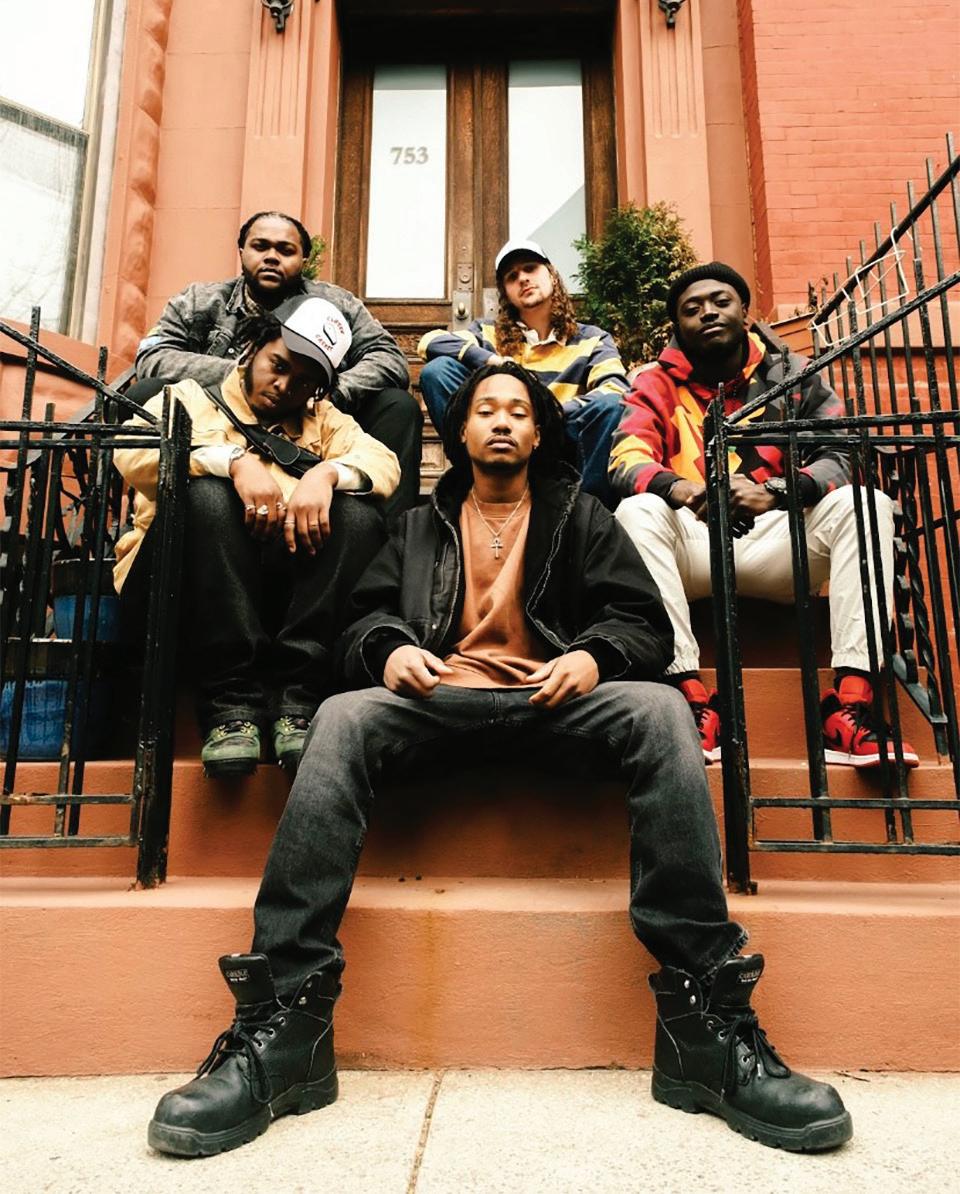
Jazzy UK art-rock band Maruja joins influences as disparate as Kamasi Washington, Swans, and Kendrick Lamar with the spirit of underground UK postrock and electronic music. Founded in 2014 by Mancunian college friends Harry Wilkinson (vocals and guitar) and Matt Buonaccorsi (bass), the group went through some growing pains and lineup shifts in their early years, and they don’t consider their first three EPs representative of their sound anymore. In 2019 they settled on their current four-piece lineup, which adds Joe Carroll (alto saxophone and vocals) and Jacob Hayes (drums), and focused on pushing their craft to the next level.
In a 2024 interview with Balkan Rock, the bandmates describe rehearsing 20 to 30 hours per week, which they kept up for years—when they stopped in 2023, it was to leave on their first tour. On “The Invisible Man,” from the 2024 EP Connla’s Well, they build mountains of aching tension over a deceptively serene bed of saxophone and drums; Wilkinson describes a loved one struggling with mental illness, climbing to an anguished repeated scream of “The truth / It hides.”
Maruja’s brand-new debut fulllength, Pain to Power , grapples with the gut-wrenching political realities of today (the somber “Saoirse” calls for solidarity with the people of Gaza) and asks what future, if any, the band’s generation has to look forward to. The album mixes hardhitting bangers with brooding, openended missives. When Wilkinson raps, he sometimes sounds like he’s trying on someone else’s suit (his verses on “Trenches” border on fratty 90s funk rap), but his

Minami Deutsch COURTESY THE ARTIST
MUSIC
continued from p. 25
exploratory crooning and fiery spoken word carry convincing emotional weight. The long-form “Born to Die” interrogates the purpose of life under late capitalism, letting the question hang in the haze of Carroll’s soaring sax leads, and then launches into a three-minute finale of cosmic metal. Album closer “Reconcile” offers catharsis and repose with a twinkling merger of postpunk and jazz. It’s hard to guess where Maruja will go from one song to the next, but they’re so evocative and engaging that you’ll want to find out.
—JAMIE LUDWIG
WEDNESDAY1
Makaya Mccraven Tom Skinner opens. 8 PM, Thalia Hall, 1807 S. Allport, $33.52. 17+
Makaya McCraven is famous for his ambition— he made his name with a sophisticated musical approach that involved crafting compositions in the studio by rearranging live recordings of his band and overdubbing new performances onto them. But even by his standards, his latest project says “go big or go home.” The jazz drummer, producer, and self-described “sonic collagist” is dropping four simultaneous EPs through International Anthem, available individually on October 31 and as a double-LP collection called Off the Record on October 10. Each EP is built from live improvisations with a different complement of musicians, and the constituent recordings were made between 2015 and 2025. Each can stand on its own, but listening to them in succession lets you discover where they align and where they diverge, sometimes wildly and unexpectedly.
McCraven made the brash, futuristic Techno Logic with UK tubaist Theon Cross (who also plays electronics) and Chicago multi-instrumentalist Ben LaMar Gay (on cornet, synths, diddley bow, and more). They captured live sets in London, Berlin, and New York, and the drummer completed the record at his Chicago studio. McCraven assembled the sleek, chill soundscapes and danceable jams on The People’s Mixtape from recordings of an ensemble that includes bassist Junius Paul, vibraphonist Joel Ross, modular synth player Jeremiah Chiu, and
Find more music listings at chicagoreader.com/musicreviews



Let’s Play!
trumpeter Marquis Hill. The dark grooves of Hidden Out! come from two 2017 dates at the Hideout with different combos (one with Paul and guitarist Jeff Parker, the other with Paul, Hill, and saxophonist Josh Johnson). Over the next eight years, McCraven painstakingly edited the recordings, adding overdubs on percussion, keys, synths, vibraphone, and guitar, but the final mixes of “Awaze” and “New Feed” don’t feel overworked—the sounds pop so vividly that you can practically see the Hideout’s wood-paneled walls. PopUp Shop revisits McCraven’s Los Angeles debut in 2015, when he played with Parker, vibraphonist Justefan, and bassist Benjamin J. Shepherd. It’s the sunniest and most upbeat of the four EPs. —JAMIE LUDWIG v
Maruja
Mei Ehara COURTESY THE ARTIST
Makaya McCraven SHANNON MARKS
CLASSIFIEDS

JOBS
USG Corporation is seeking an IT Technical Specialist in Chicago, IL w/ the following reqmnts: Bachelor’s deg in Comp Info Systems or Comp Sci or rel field or foreign equivalent deg. 5 yrs of rel exp w/ following responsibilities: Administer, maintain, & optimize enterprise applications such as Oracle E-Business Suite (EBS), Oracle Access Manager, Oracle Apex, Oracle Business Intelligence, & other integrated solutions & 2-3 days of remote work is allowed. Must live w/ in normal commuting distance of Chicago, IL. Salary: $120,000$135,000/yr. Rate of pay may be adjusted based on the qualifications & exp of the candidate. USG offers benefit options for employees & their families, including two medical insurance options, vision, & dental coverage. The cost of these optional prgrms varies based on coverage level. Coverage options are offered on day one.
USG offers a 401(k) Plan w/ company match, a pension plan, as well as a number of additional prgrms like paid time off, paid holidays, life insurance, accident insurance, legal insurance, just to name a few. USG also offers bonus potential for all employees. Please visit www. usg.com/careers to view the entire job description & apply.
Computer/IT: Beyond Finance (Chicago, IL) seeks experienced professionals to fill the following openings: Senior Data Analyst ($97,000-$144,000), Senior DevSecOps Engineer ($144,000$174,000), Senior Analyst, Marketing Analytics ($80,000-$120,000), Senior Analyst, Marketing Analytics ($97,000$144,000), Manager of Marketing Analytics ($97,000-$132,000) and Strategy & Operations, Senior Associate ($89,600$134,400). See details at beyondfinance. com/careers. Work is performed in co’s office in Chicago w/some remote work permitted
per co policy. Benefits inc. co contribs for H/D/V, generous PTO, holidays, parental leave, 401(k) match, merit adv. opps, career dev. & training. Apply: Send resume to bllcrecruiting@ beyondfinance.com with the job title in subject line. Financial seeks a Senior Software Engineer in Chicago, IL to develop software designs and architecture. 100% Telecommuting permitted. Offered Wage: $106,000$171,000/yr. Med/Dent, Vision, AD&D, Vol Life Ins, STD, LTD, Crit Ill, Grp Legl Ins, Conn Stip, EAP, Acc Ins, Hosp Ind, FSA/ HSA, 401K. Apply: https:// www.jobpostingtoday. com/ Ref # 18122.
Are you passionate about making a positive impact in the life of my Mother?
I am seeking a dedicated & compassionate caregiver to take care & provide exceptional care for my mother. As a caregiver, you will play a crucial role in supporting my mother who is Elderly. Schedule is 5 days a week & 5 hours per day. Salary is $30/hr. Apply by contacting me via email at George (gwssheets@ gmail.com) for more details.
Engineer Senior. Elevance Health, Inc. Chicago, IL. Responsible for delivery of end-to-end application.
BS: IT, CS, or rel. 5 yrs dev, engg or rel exp. Alt Reqs: MS & 3 yrs exp. Other exp reqd. Pay: $148,949$149,949/yr. Apply: https:// careers.elevancehealth. com/. Job Ref: JR162321
Project Engineer IV sought by Quandel Consultants Inc. in Chicago, IL to dsgn complex project, system, component or process. Reqs: Bach deg, or foreign equiv, in Civil Engg or rltd field & 2 yrs exp in job offd or in tech dsgnr capacity. Must possess exp w/ transportation engg s/w (Bentley CAD/Autodesk CAD) to produce railroad & highway geometry dsgn, assess traffic patterns through AutoTurn,
generate construction drawings, & conceptualize 3D infrastructure solutions; design 3D linear transportation corridors & dvlp crosssections; & etc. Upon hire must obtain proper IL pro engg license w/in 6 mos. Salary: $98,280/ yr. 5% domestic travel req. Email resumes to: T. Weitzman at tweitzman @quandel.com; Ref job 101.
Service Payment Plan, INC seeks F/T Data Scientist in Chicago, IL to support its business operations by using advanced data analysis techniques, including AI, statistical modeling, and quantitative analysis, to perform market research and improve the company’s products and decision-making processes. Remote work option for 2 days/week. Master’s deg. req. in Business Administration or Economics, related or equivalent, with at least one university-level course each in A.I. and Data Analytics. 24 mo. exp. as a Data Analyst and 24 mo. exp. with SQL, Qlik, and either Python or R is required. $110,000120,000/yr, med., dent., vision, life, disab., transp. and ret. benf’ts. Send CV and references to Service Payment Plan, INC at 303 E. Wacker Dr., Ste. 2000, Chicago, IL 60601.
LanzaTech, Inc. seeks an Associate Automation Engineer in Skokie, IL to maintain, calibrate and test lab automation instruments. Reqs. MS+2 or BS+5 yrs. exp. Salary range: $109,845.00 to $114,845.00 per year. To apply, mail resume to LanzaTech Inc., Attn: HR, 8045 Lamon Ave, Suite 400, Skokie, Illinois 60077 OR submit a resume to https://illinoisjoblink. illinois.gov/, OR submit a resume to https://jobs. dayforcehcm.com/ en-US/lanzatech/ LTCAREERS. Must reference Job Title & Job Code: 000094. EOE.
Enova Financial Holdings, LLC seeks a Product Manager in Chicago, IL to dvlp & maintain feature roadmap. Salary $107,500 - $107,500. Please apply https:// www.jobpostingtoday. com/ Ref # 73824
Senior IT Engineer. Ulta, Inc. Bolingbrook, IL. Dev and exec test plans to validate the implementation. BS: CS, CIS or rel. 5 yrs lead quality engg activity. Other exp req. Can work remotely or tele 50%. Pay $125,000/126,000 yr. Apply: https://careers. ulta.com/careers/ Job ID 399652
South Loop DentalQ seeks F/T Dentists for Chicago location.[HEX:a0] [HEX:a0]Must have DDS or DMD degree or foreign equivalent and valid IL dental license. Sal range $150-$160K/yr. Send resume to drmahi@ lincolnshinedental.com

SERVICES CHESTNUT
ORGANIZING AND CLEANING SERVICES: especially for people who need an organizing service because of depression, elderly, physical or mental challenges or other causes for your home’s clutter, disorganization, dysfunction, etc. We can organize for the downsizing of your current possessions to more easily move into a smaller home. With your help, we can help to organize your move. We can organize and clean for the deceased in lieu of having the bereaved needing to do the preparation to sell or rent the deceased’s home. We are absolutely not judgmental; we’ve seen and done “worse” than your job assignment. With your help, can
we please help you? Chestnut Cleaning Service: 312-332-5575. www.ChestnutCleaning. com www. ChestnutCleaning.com

HOUSING
Incredible inexpensive
1 bdrm apartment
20 minutes from U of C campus
Apartment features: 1. Hardwood throughout 2. New kitchen
3. Spacious rooms
4. Lots of outdoor space
5. Organic garden
Rent is $985.00
Available October 5th
Eamonn@midcontinental buildingcorp.com

ANNOUNCEMENTS
WHERE IS GOD?
No need for a Schindler, MLK in Heaven. No need for a Soldier in Heaven. No need for a Hero in Heaven. No need for an Einstein in Heaven. No need for those who fight hate, discrimination, poverty in Heaven. No need for a Plato, Socrates in Heaven. No need for a Doctor, Nurse in Heaven. No need for those who want to help those in need in Heaven. ALL are needed here, and God is with them. GOD IS WITH THE LIVING, NOT THE DEAD! For more visit: HeavenVs Reincarnation.com
Eric Zorn 12/19-20 Mariachi Herencia de México A Mariachi Christmas 12/21 The Nut Tapper 2/13/26 Drink The Sea featuring members of R.E.M., Screaming Trees, and Them Crooked Vultures
THURSDAY, OCTOBER 2 8PM
Kurt Elling with Christian Sands In Maurer Hall
Mould (Solo Electric) with special guest David Barbe In Maurer
THURSDAY, OCTOBER 9 7PM & 9:30PM Hiss Golden Messenger with special guest Rett Madison In Szold Hall
FRIDAY, OCTOBER 10 8PM L. Shankar Honoring Zakir Hussain In Maurer Hall
SUNDAY, OCTOBER 12 7PM Catherine Russell In Szold Hall
WEDNESDAY, OCTOBER 15 7PM Cory Doctorow & Anand Giridharadas on "Enshittification"In Maurer Hall



















